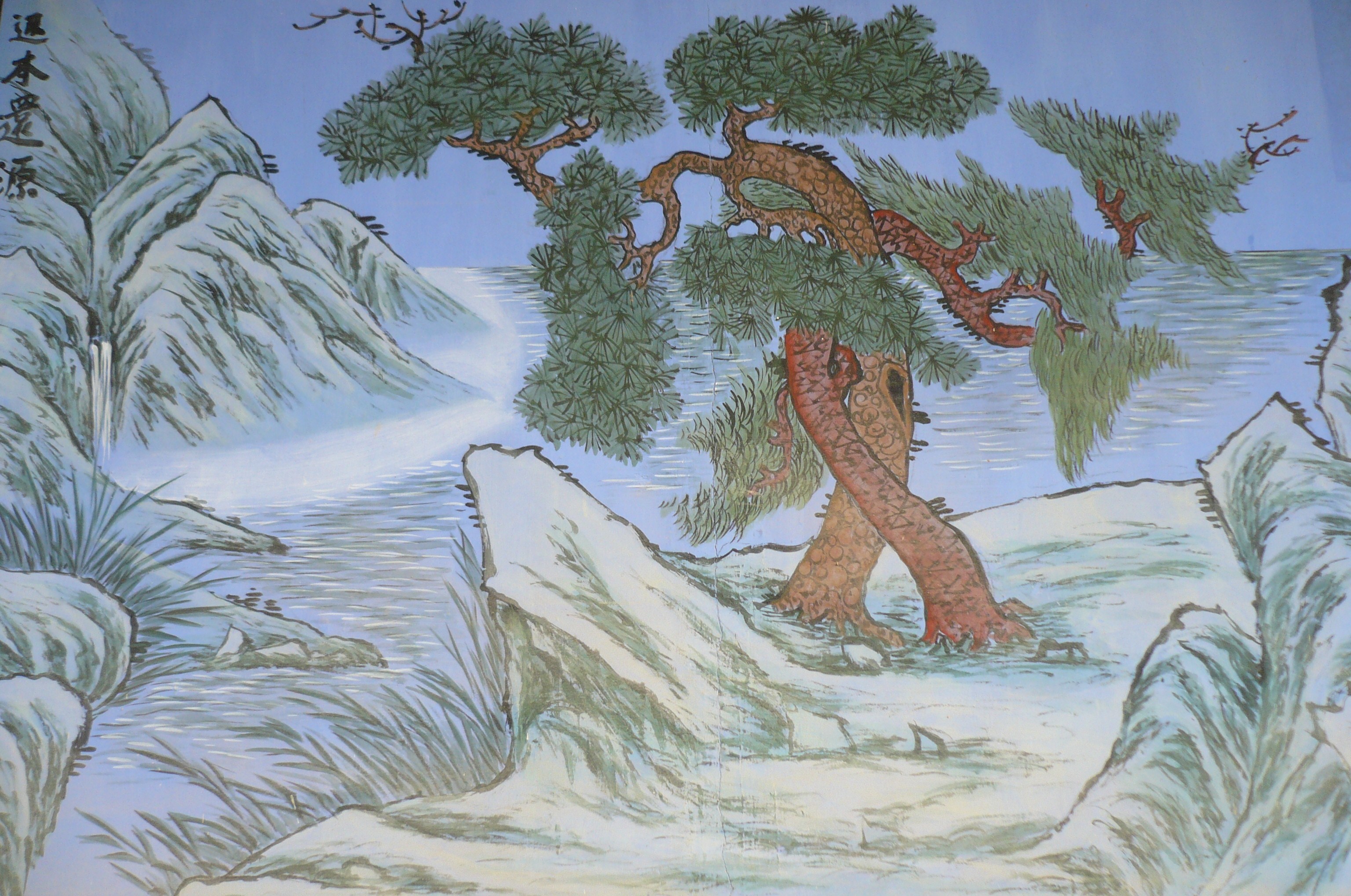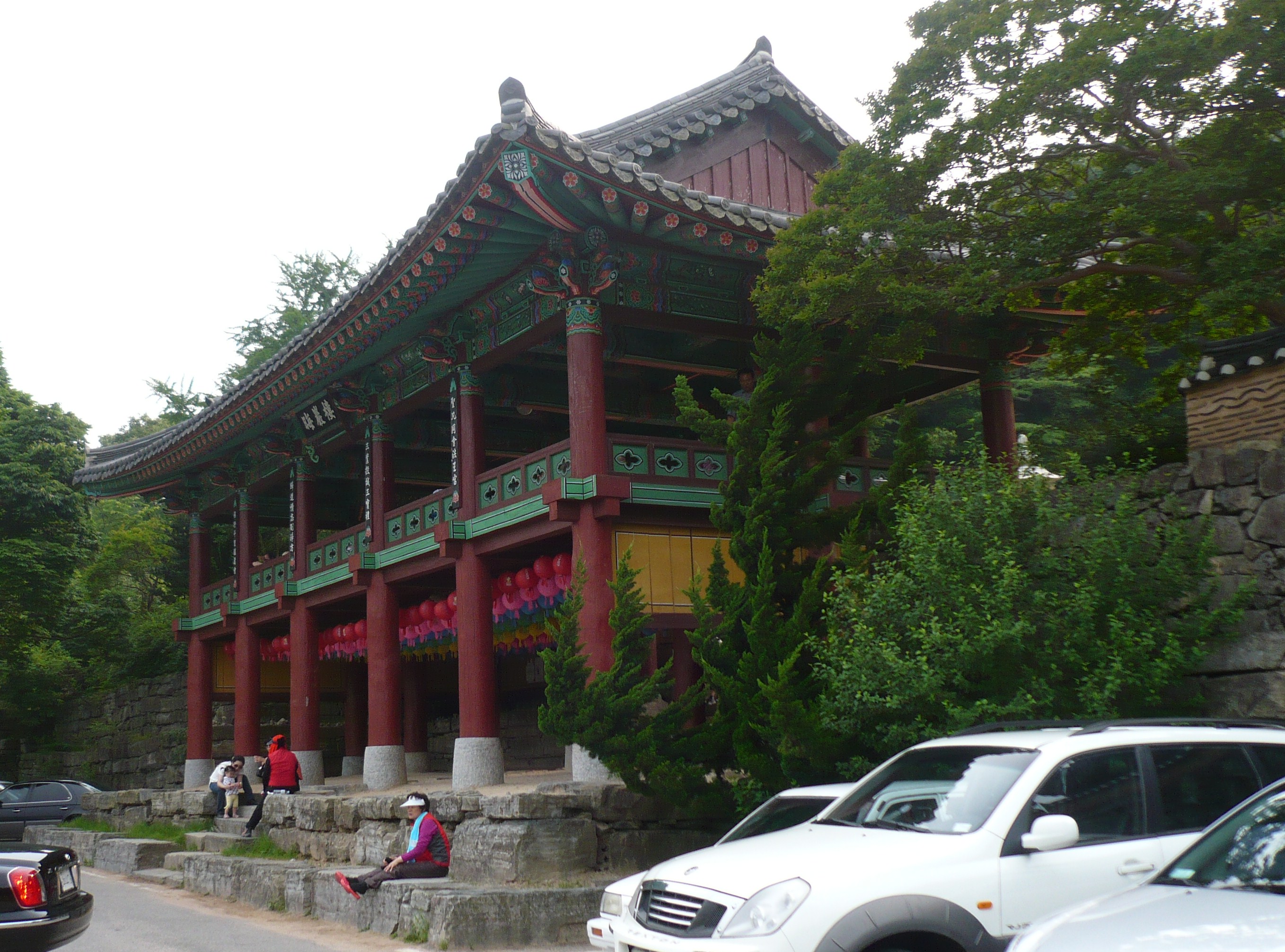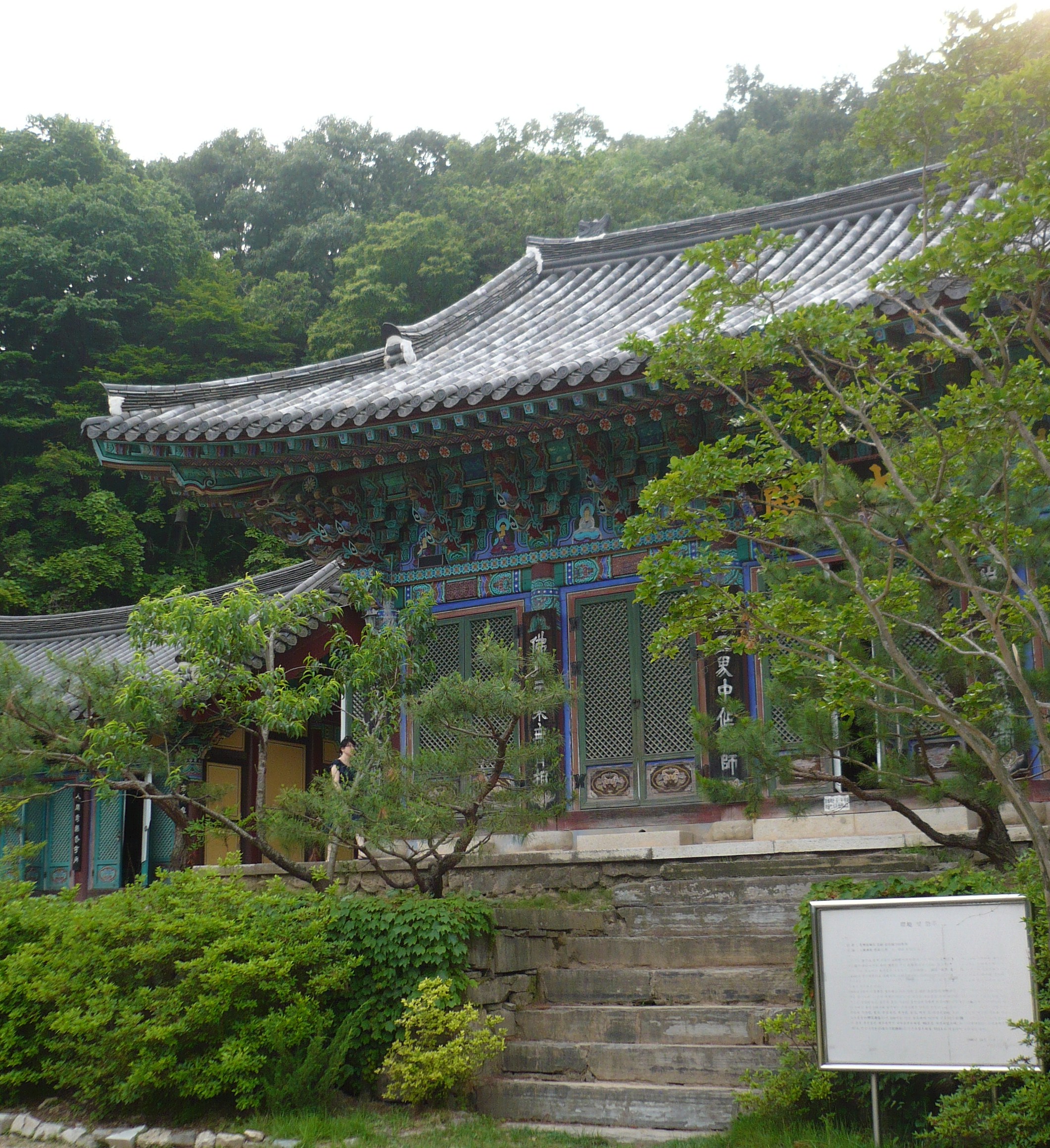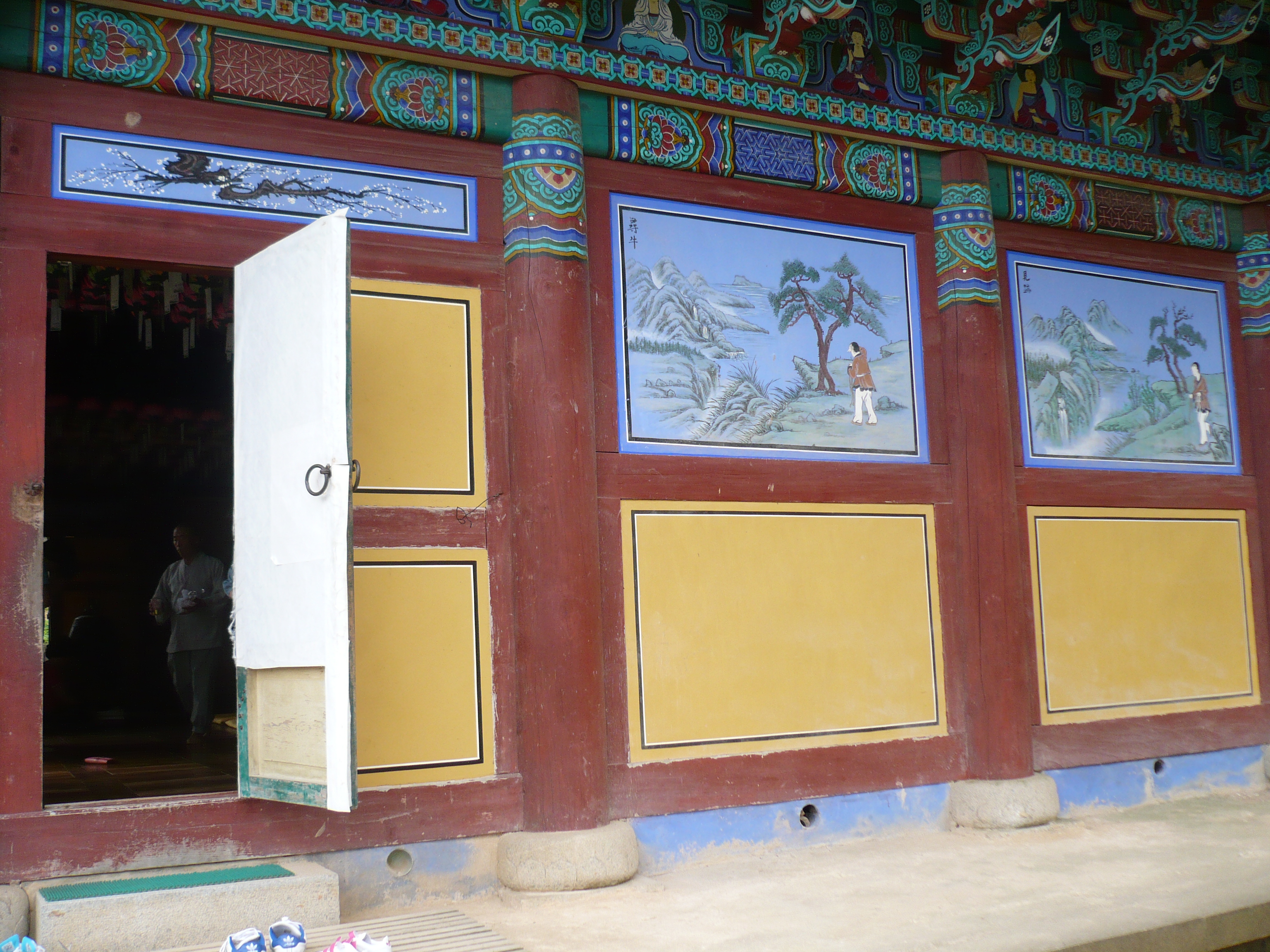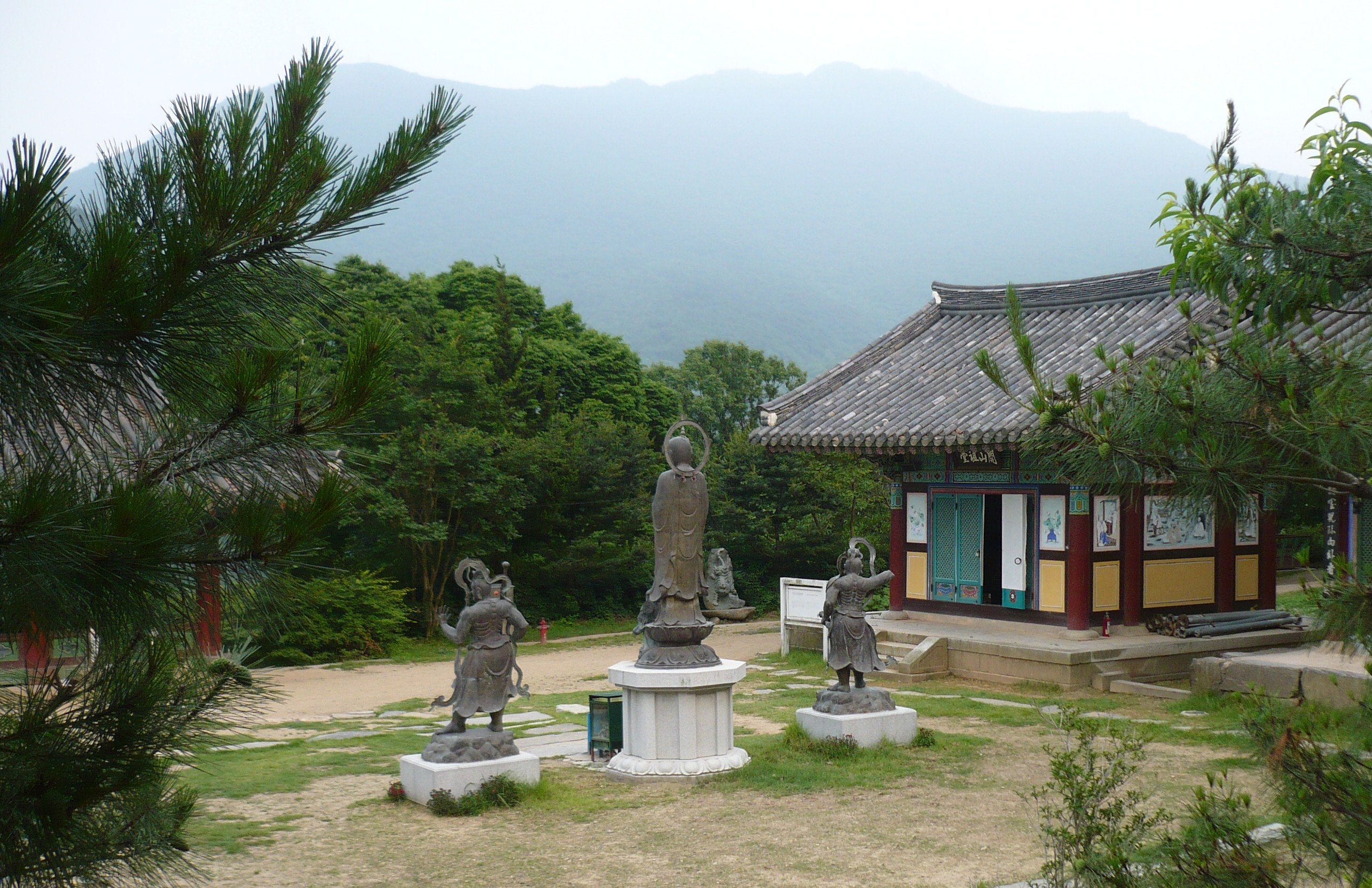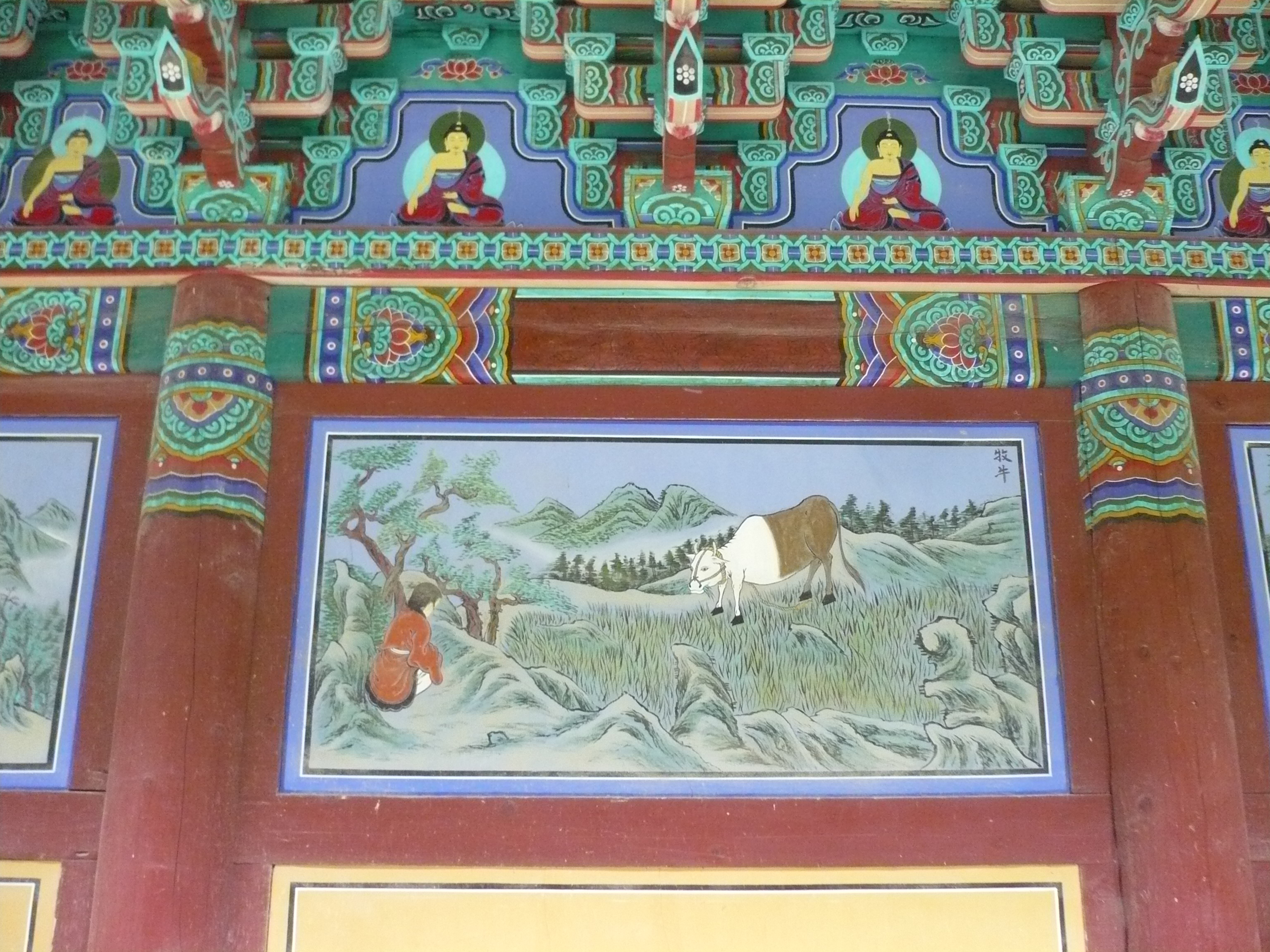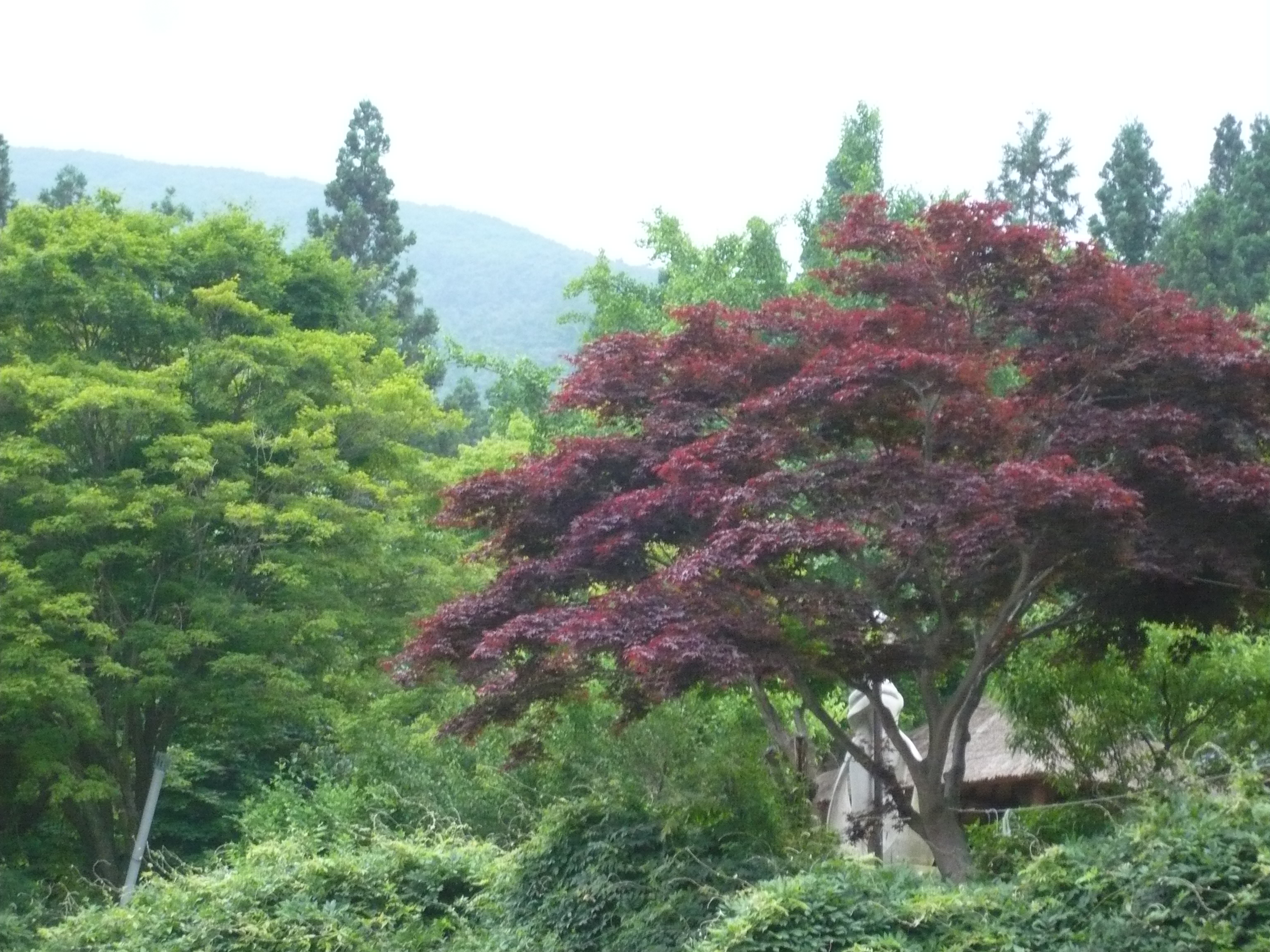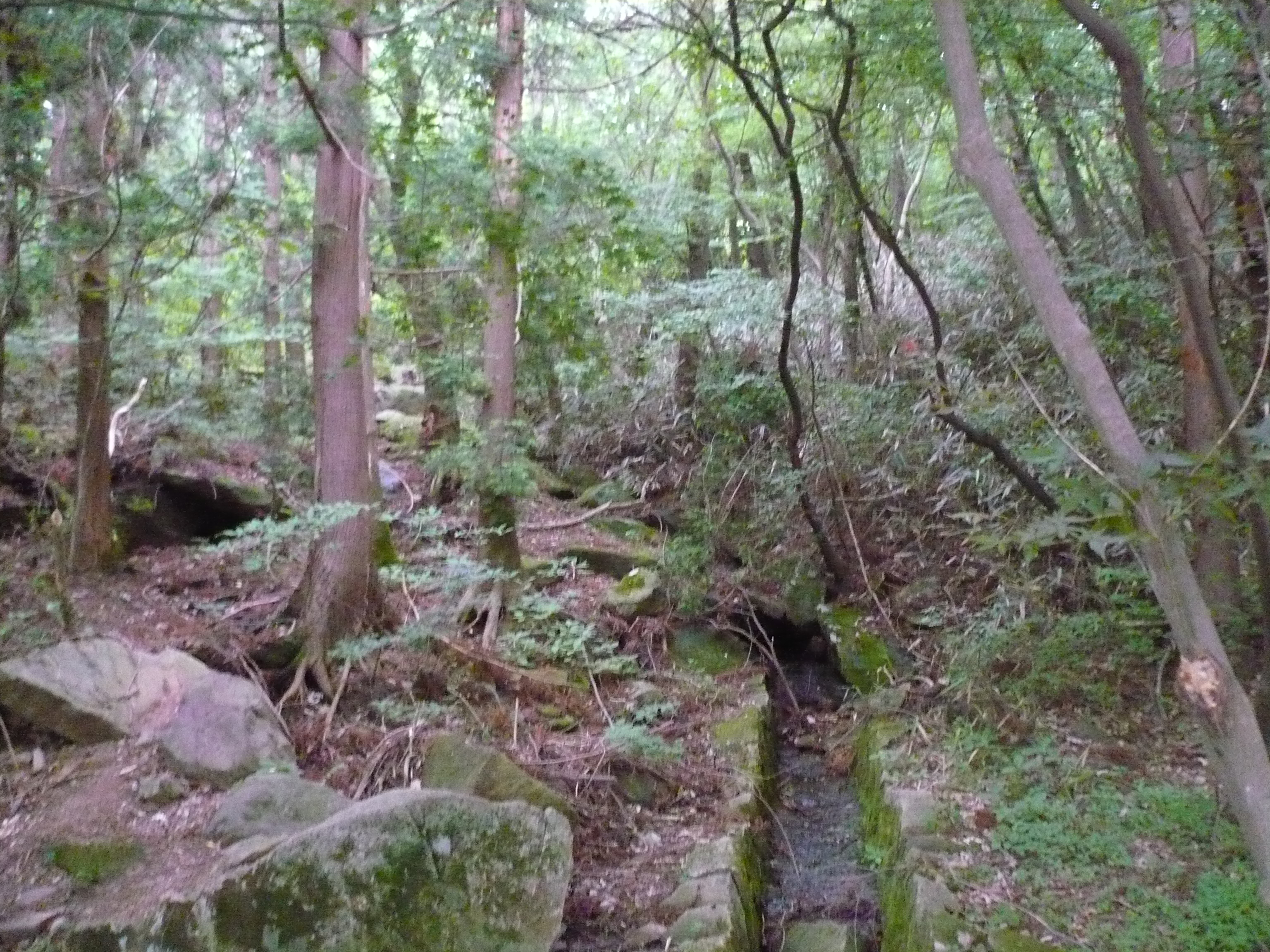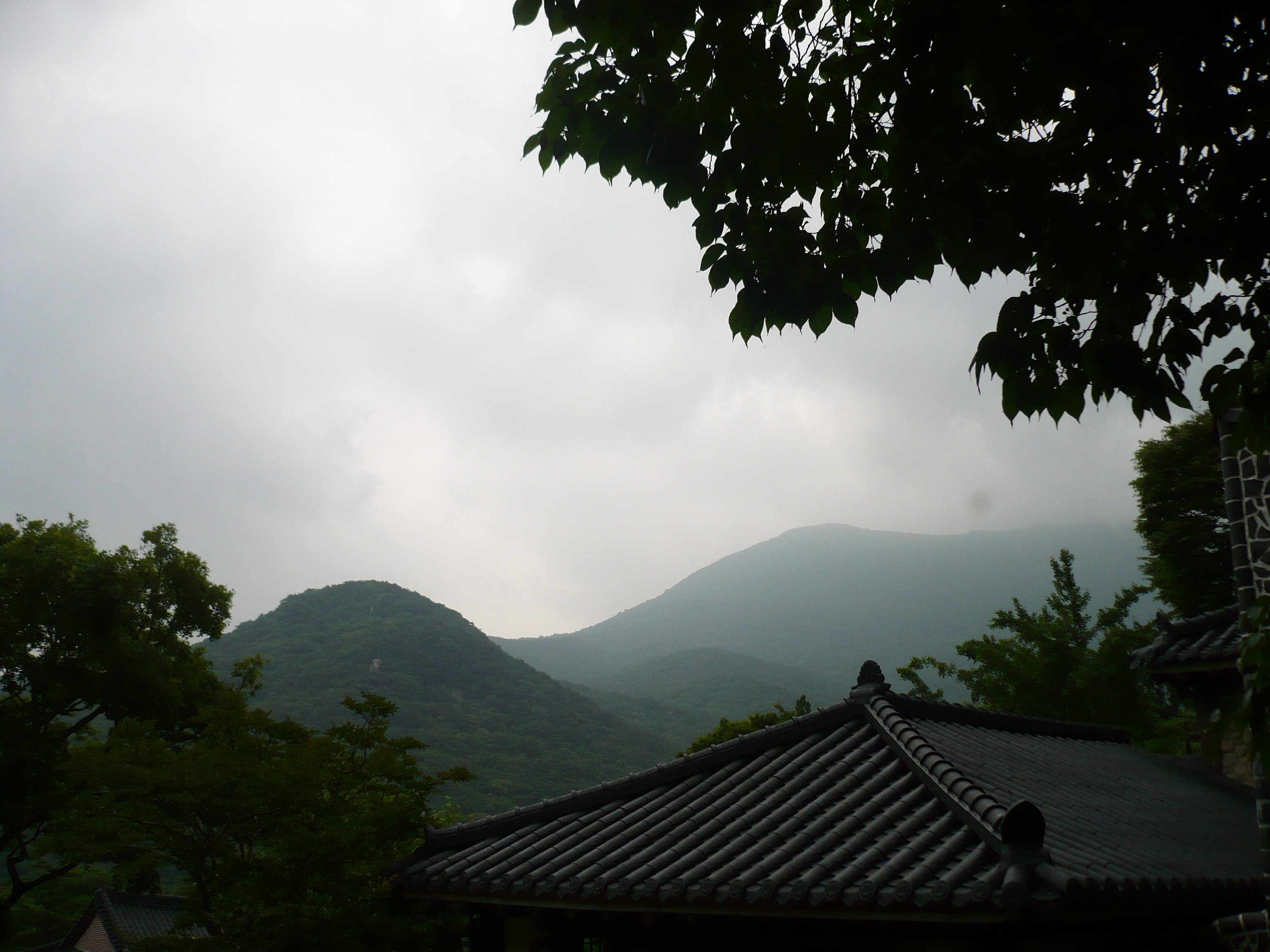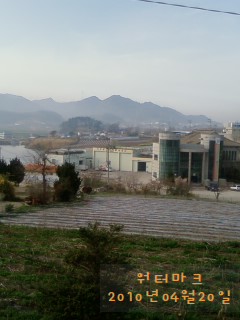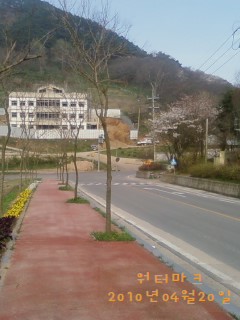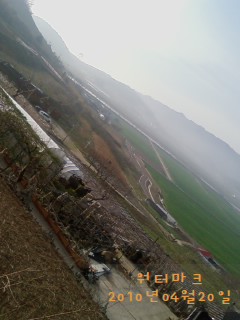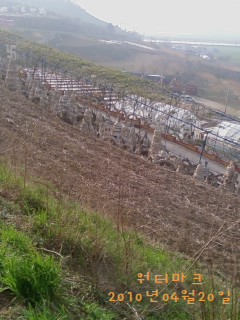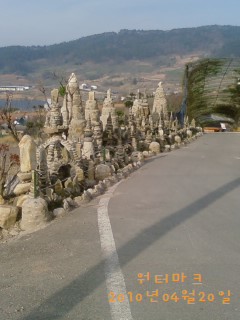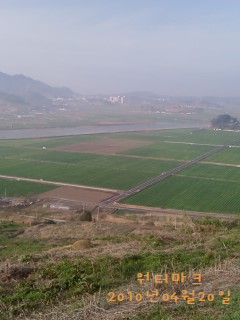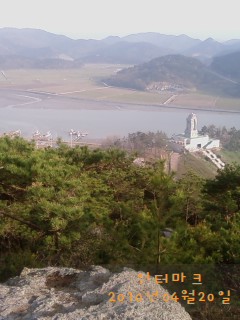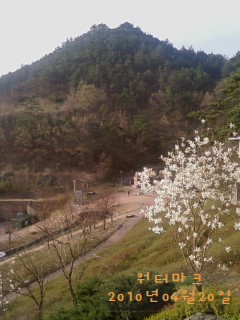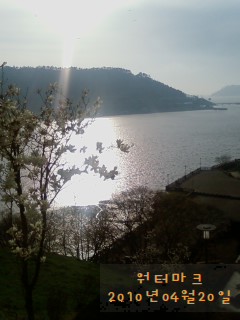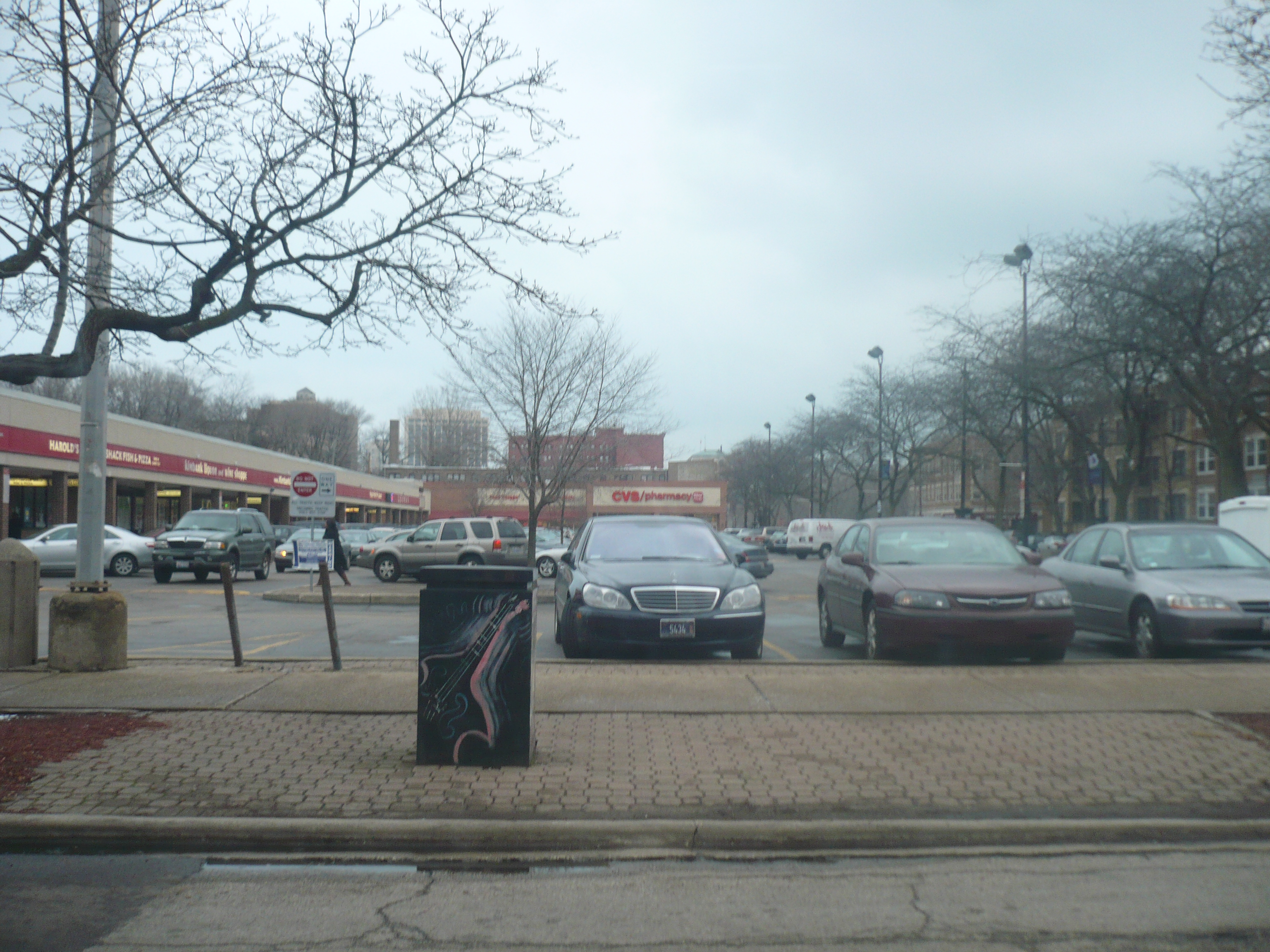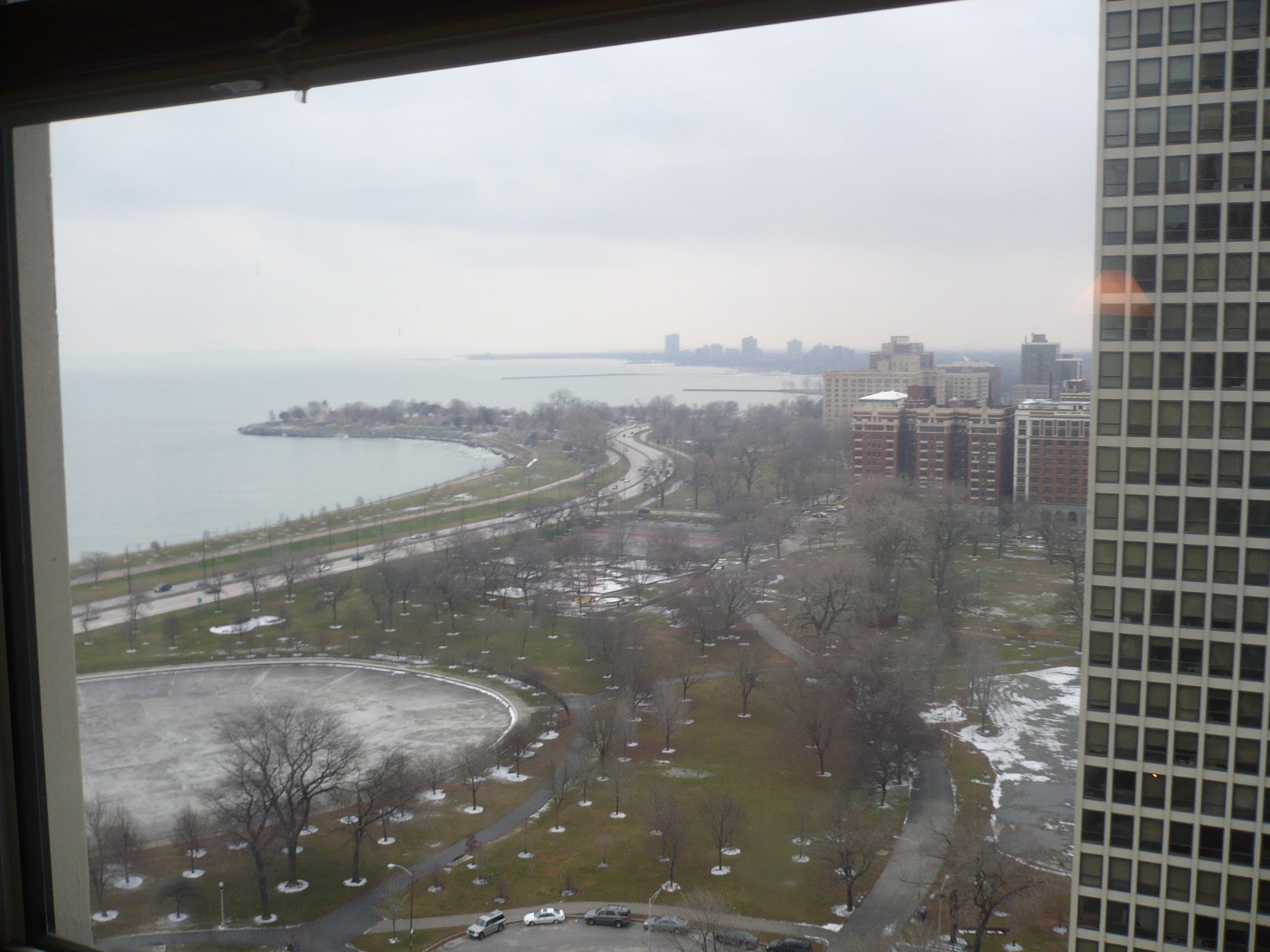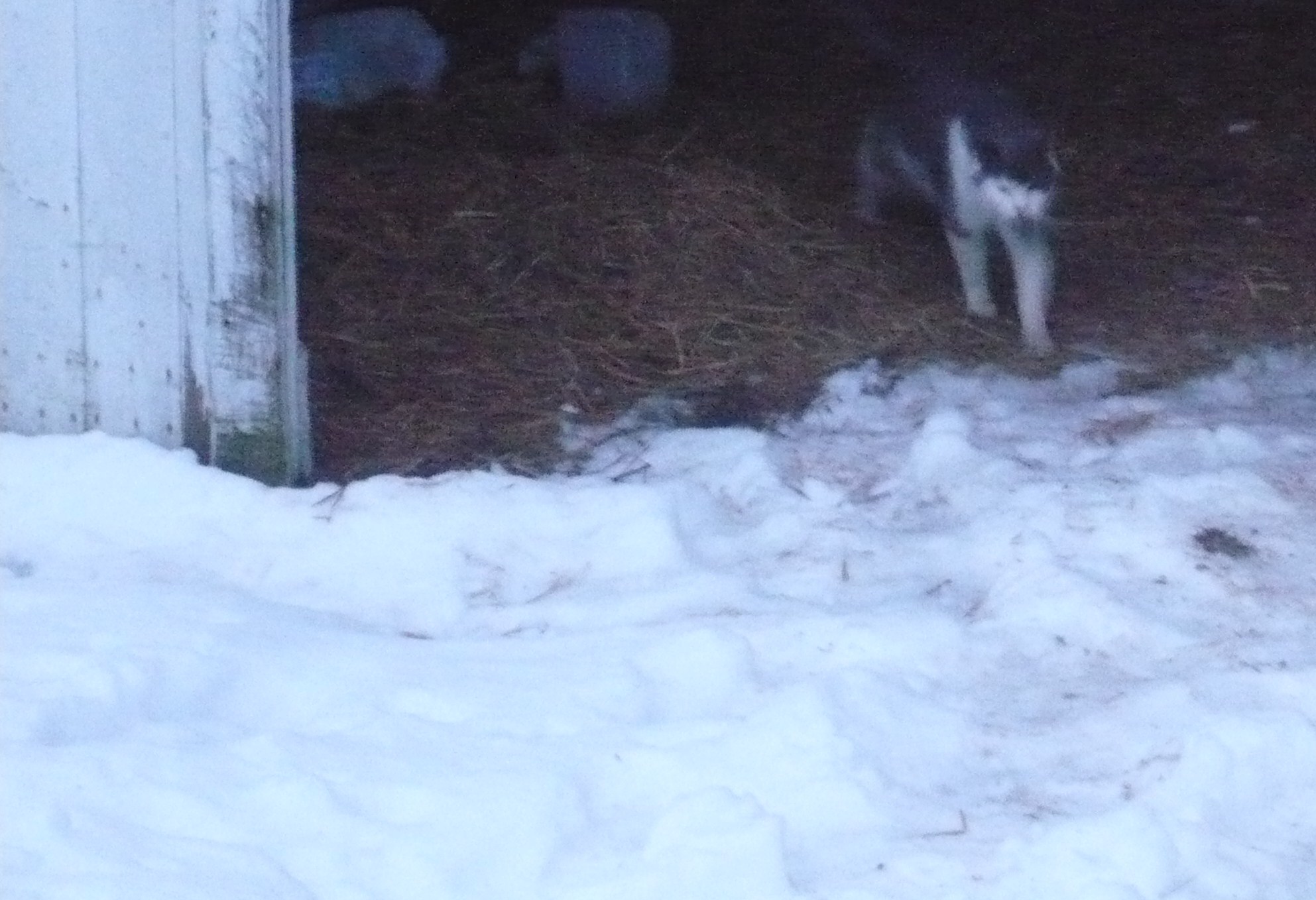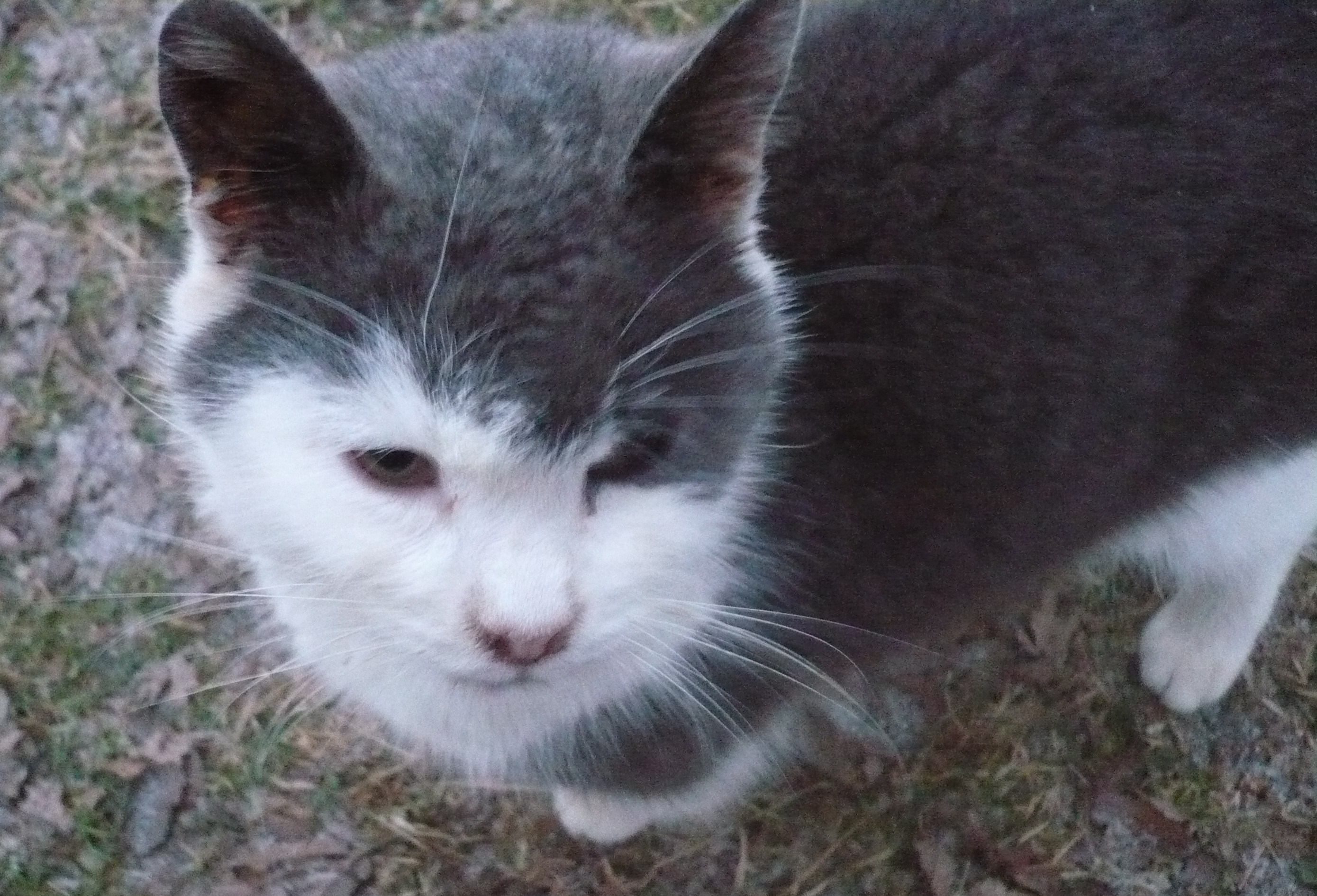These are some pale blue paintings from temple walls. I took these pictures a while back but decided to post them now because I can’t think of anything else I want to write just at the moment.
Category: Buddhism & Zen
Caveat: 원효사
My friend (and colleague at work) Byeongbae took me to his home, where I met his wife. He lives in a very modern and nice apartment in a modern development in the southeast part of Gwangju – the area reminded me a lot of Ilsan, actually. Here is a view from his apartment.
After that, he said every Saturday he goes to a bathhouse. He invited me to accompany him. I’ve always thought the Korean bathhouse tradition was cool, but I admit I often feel uncomfortable as a “foreigner” going to them – so it was nice to go with someone as a “guest.” It was actually very relaxing. After that, he and his wife and I drove out the eastern flank of the city, in Mudeung Mountain Park (actually near the hotel where I stayed during my orientation). We visited a temple there called 원효사 (Wonhyosa). I took some pictures.
His wife joined some friends at maintaining a vegetable garden that is in the woods near the temple.
Here is my friend, hamming it up a little bit beside his car, while we waited for his wife and their friends to get back out of the woods.
[this is a “back-post” added 2010-06-21]
Caveat: Be lamps unto yourselves
"Do not accept what you hear by report, do not accept tradition, do not accept a statement because it is found in your books, nor because it is in accord with your belief, nor because it is the saying of your teacher. Be lamps unto yourselves." – Gautama Buddha.
This is why I am more interested in Buddhism, despite my confident atheism, than in other religious traditions. It offers a sort of "freedom of conscience" that e.g. Christianity, Judaism, Hinduism or Islam don't appear to offer. When I say, "I'm an atheist," I have had more than one Buddhist answer, simply, "That's OK." It's hard to imagine a Christian saying that.
Caveat: “백제불교문화최초도래지”의 사진
Here are some low-rez cellphone pictures from my long walk to the monument to Baekje Buddhism site that I visited yesterday.
Caveat: A random picture
Or not so random. From my archive. Pictures taken during my visit to 금산사 (geum-san-sa) last month. Because I have nothing interesting to write. Or rather, more accurately: I have lots of interesting things to write about, but I’m feeling inhibited about doing so.
Caveat: 금산사…
I went on a “templestay” tour to Geumsansa over the weekend. Here are some pictures.
Here is the main entrance to the provincial park that hosts the temple, down by the parking lot:
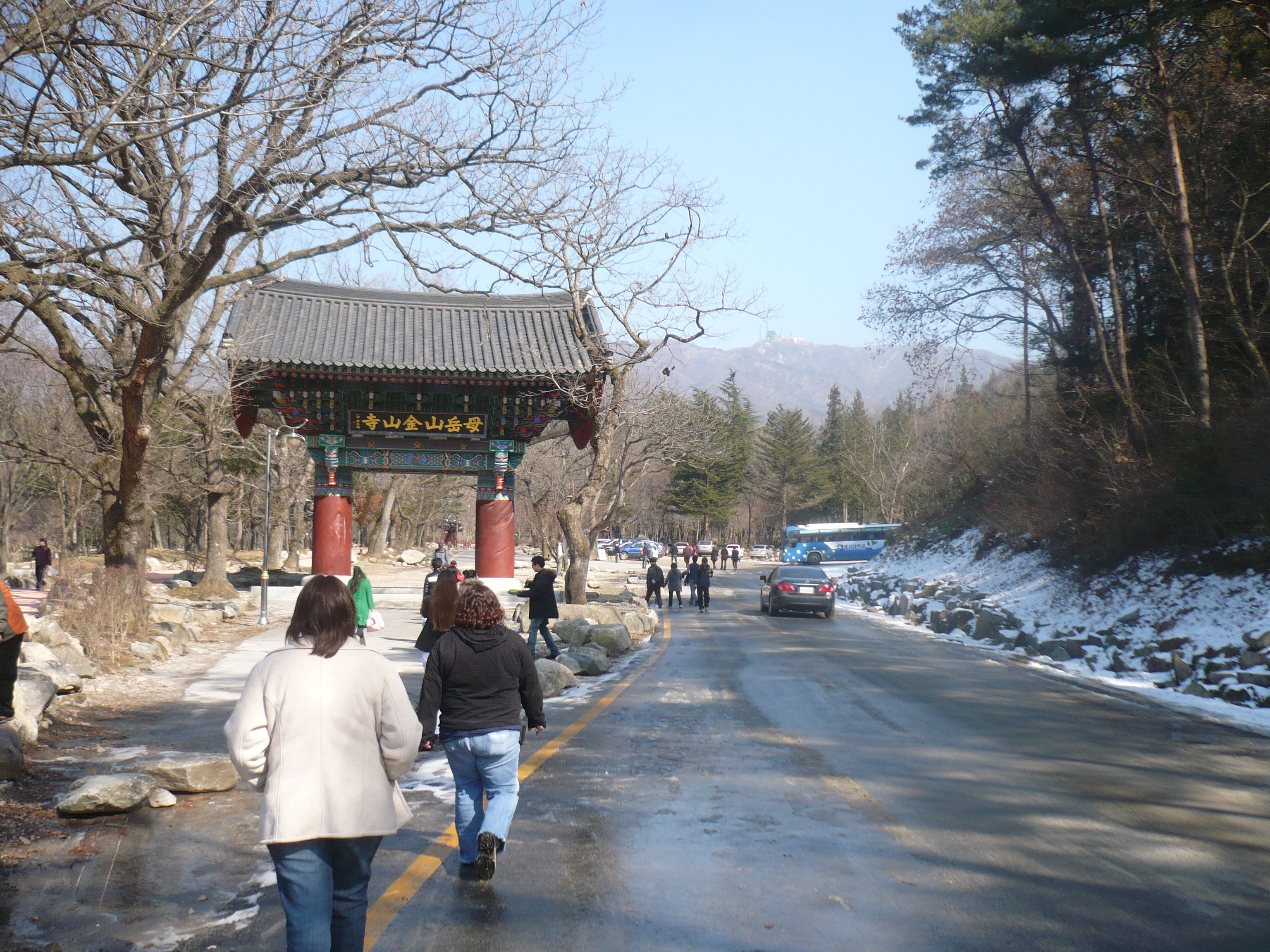
This is a turtle statue near the entrance to the temple complex:
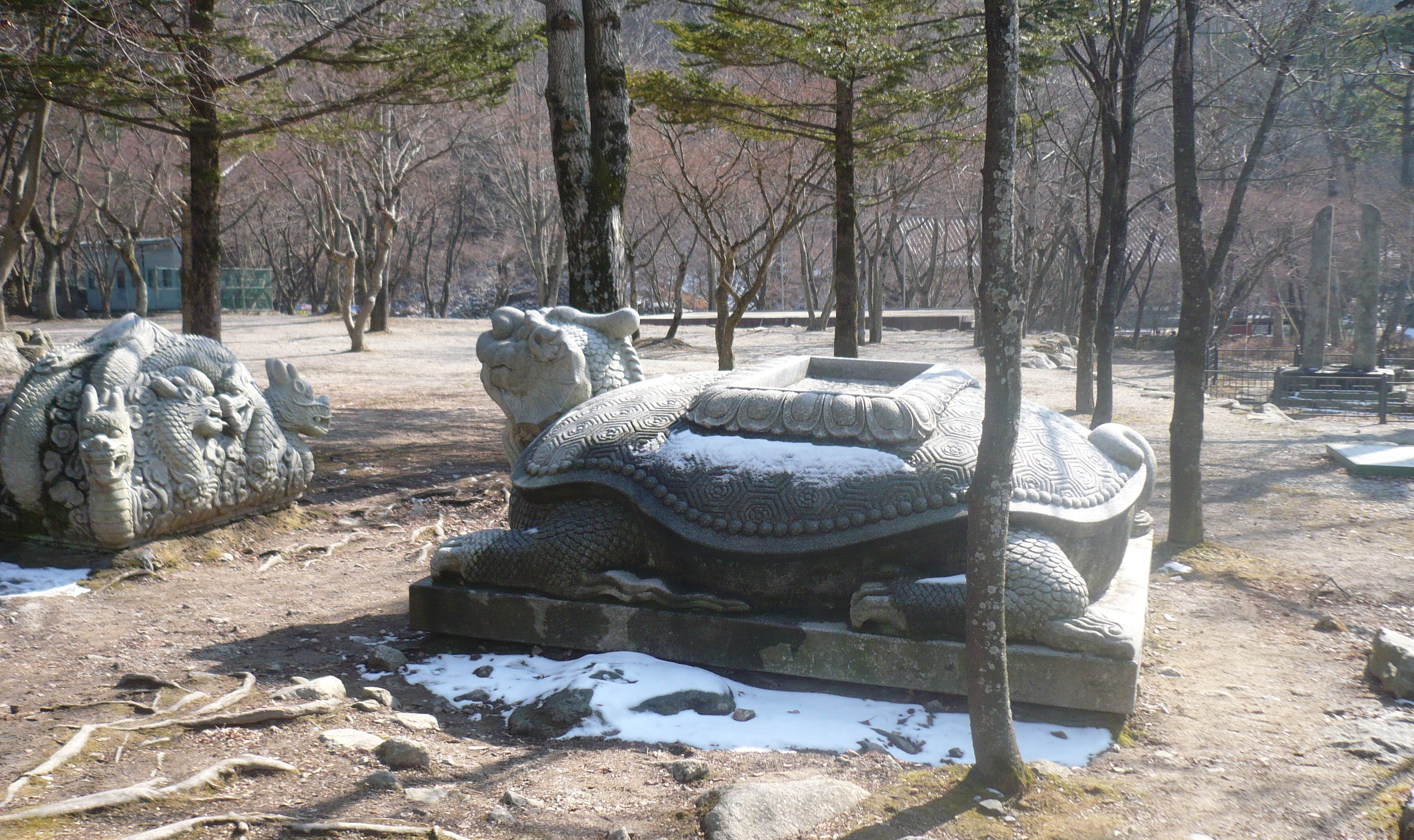
Here is a view of the main stupa (left, over a 1000 years old, though repeatedly rebuilt) and big old main temple (right, 400 years old, currently being restored due to arson by some right-wing Christian group):
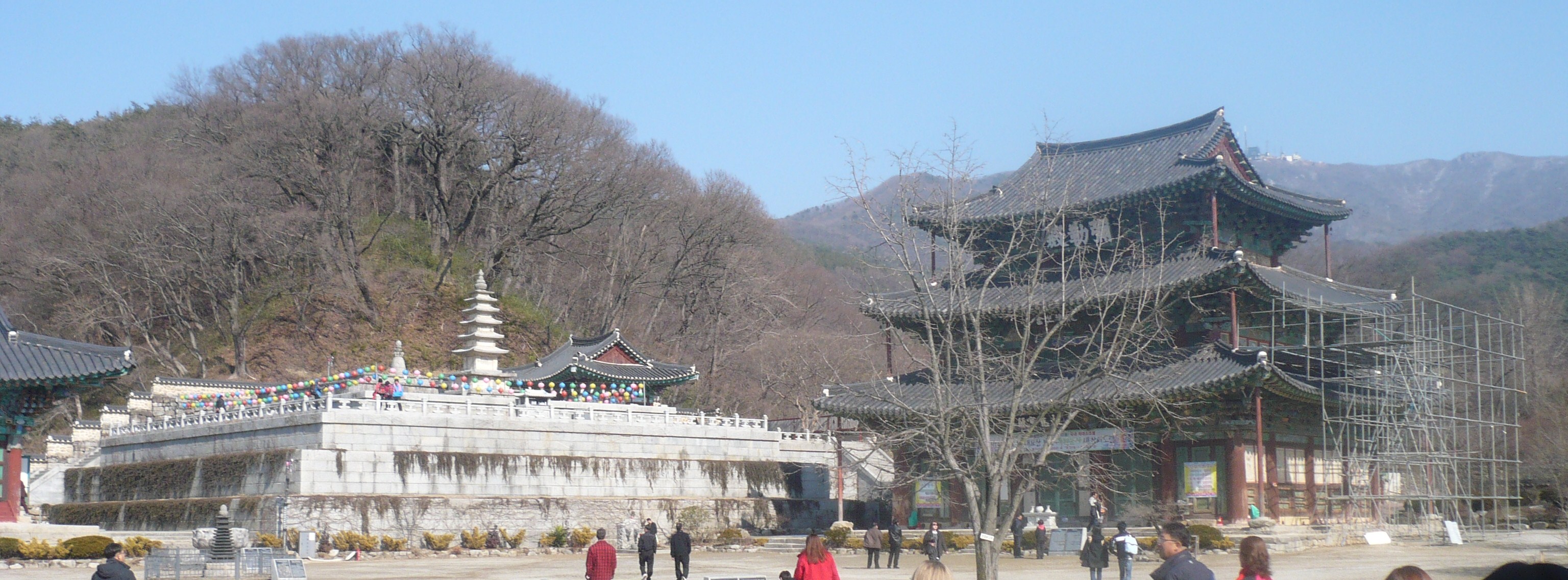
Architectural detail on the structure housing the old drum, bell, and gong:
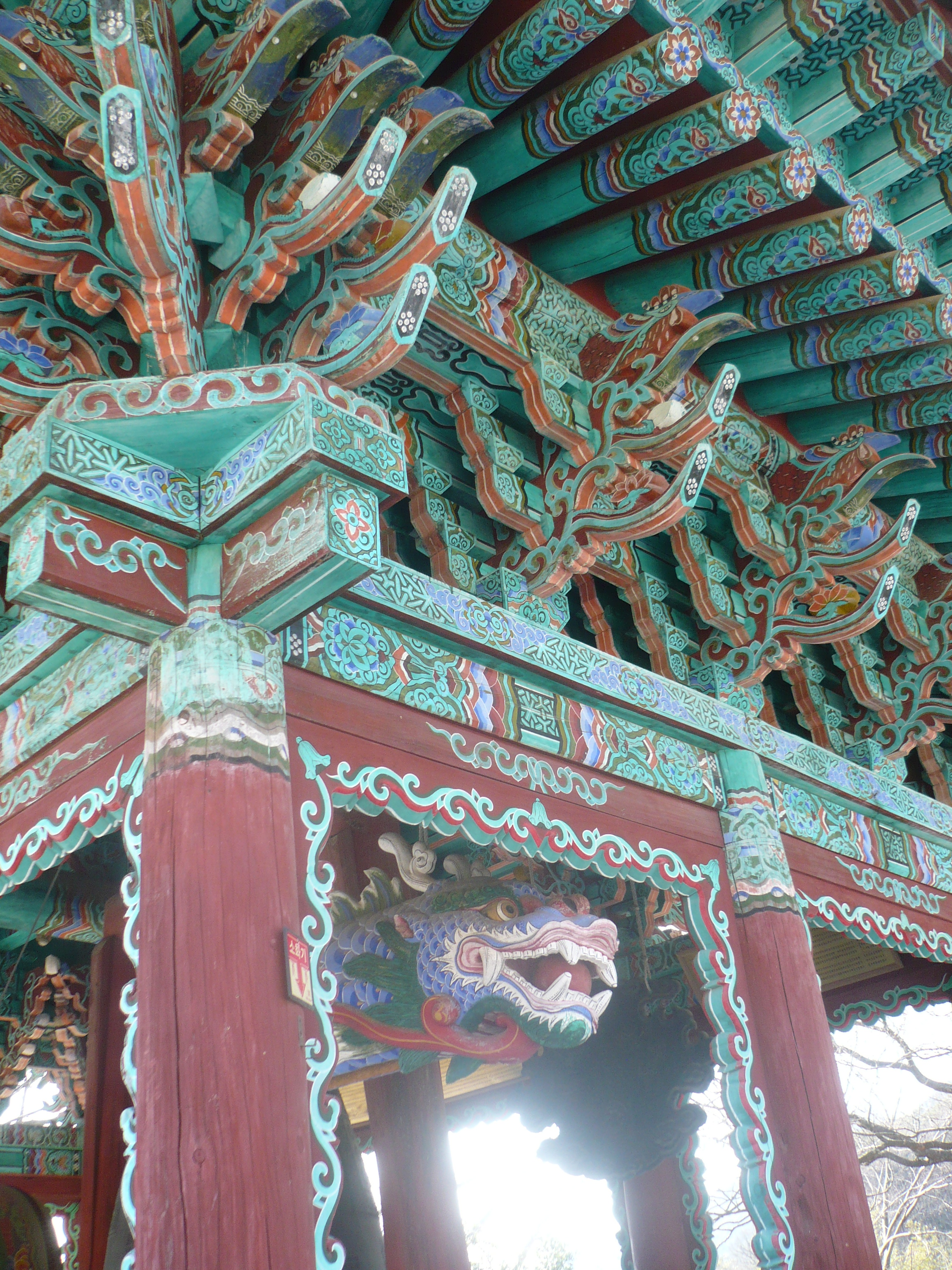
A cool painting on the side of a side-building:
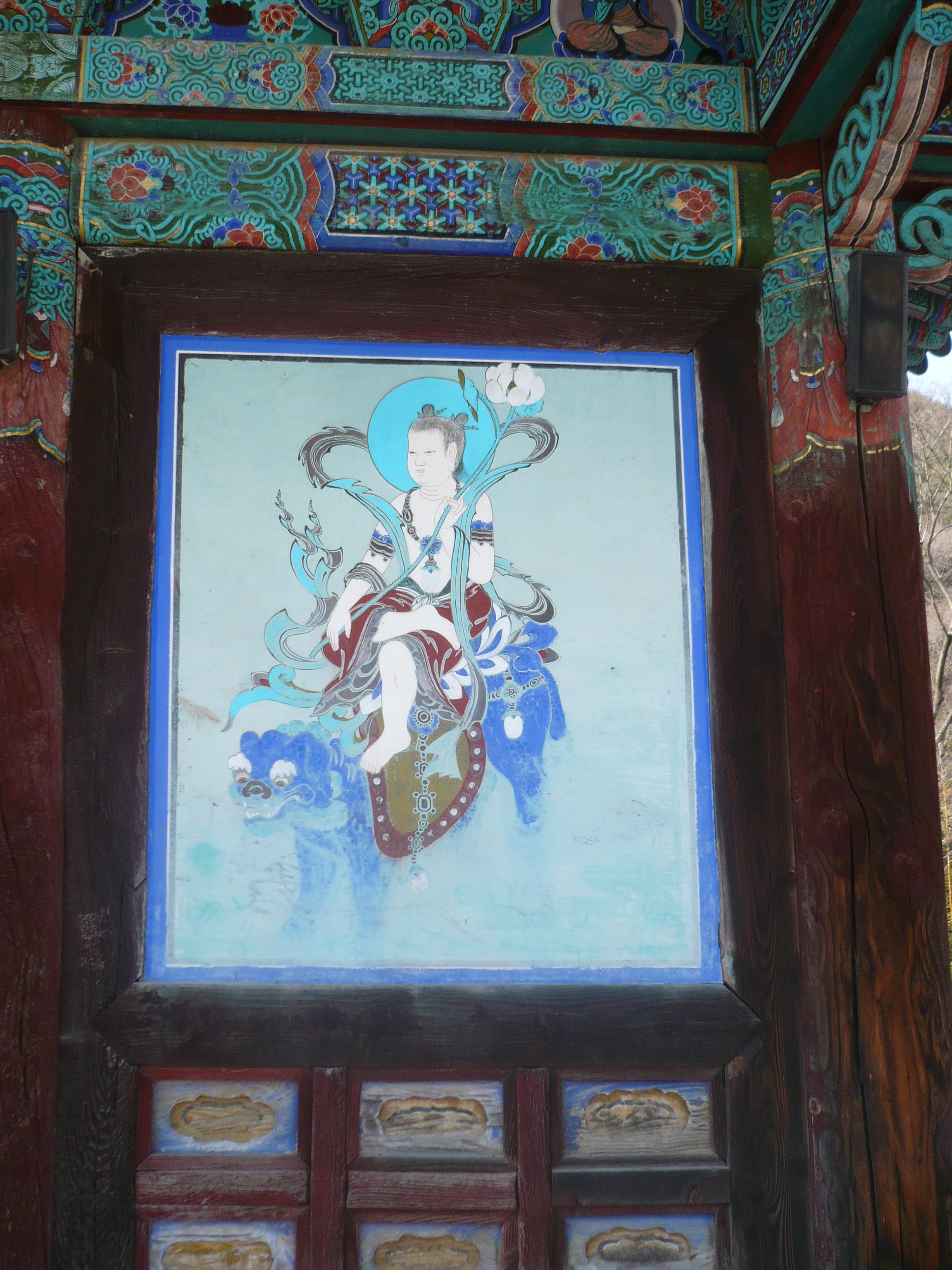
The entranceway to a small temple dedicated to Chijang Boddhisattva (I think), with the statues visible inside (this is where I did my 108 prostrations, see farther down):
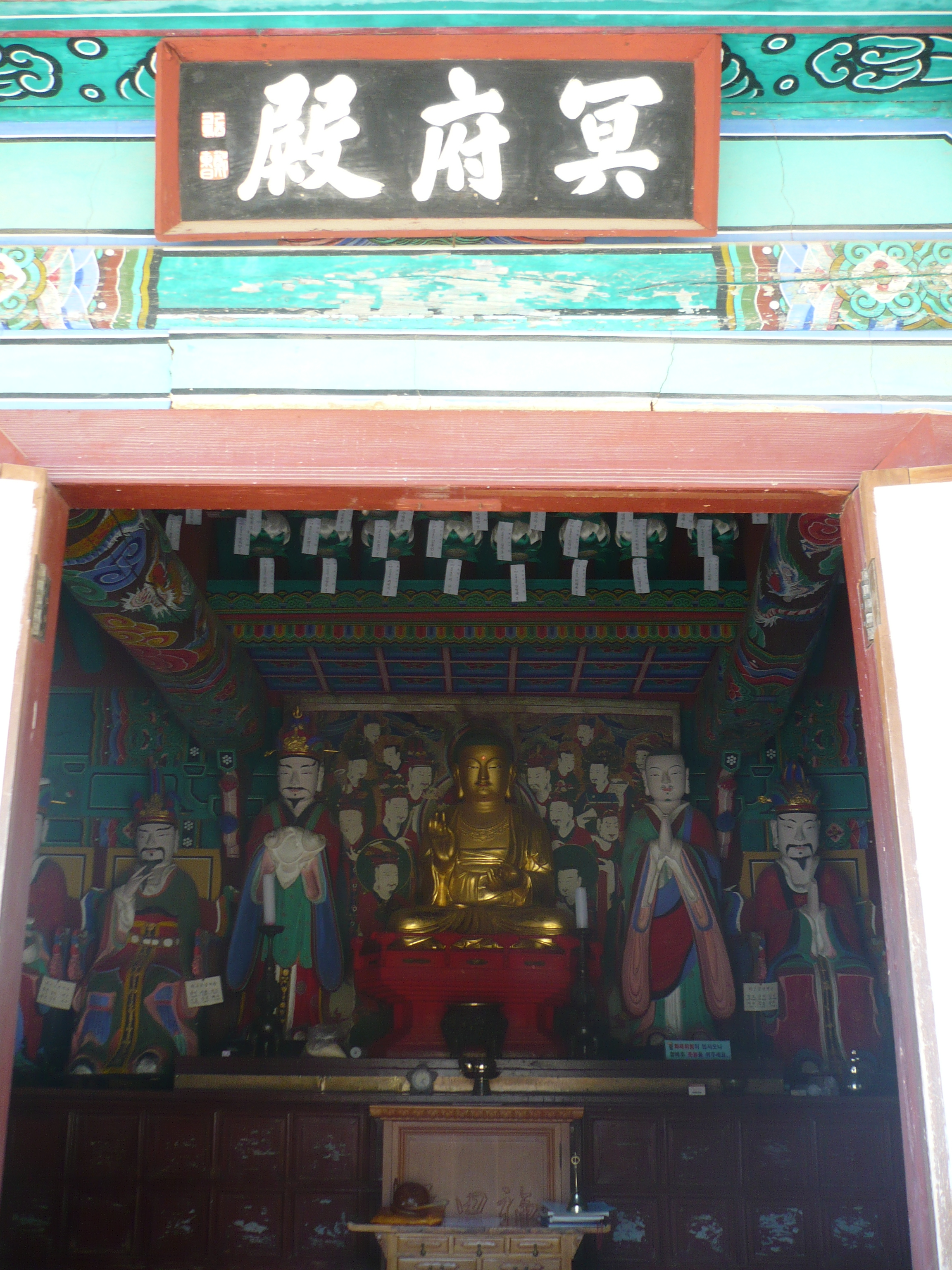
A view of the main temple courtyard looking back toward the entrance building (a modern building but in the traditional style), and the gong structure off to the right:
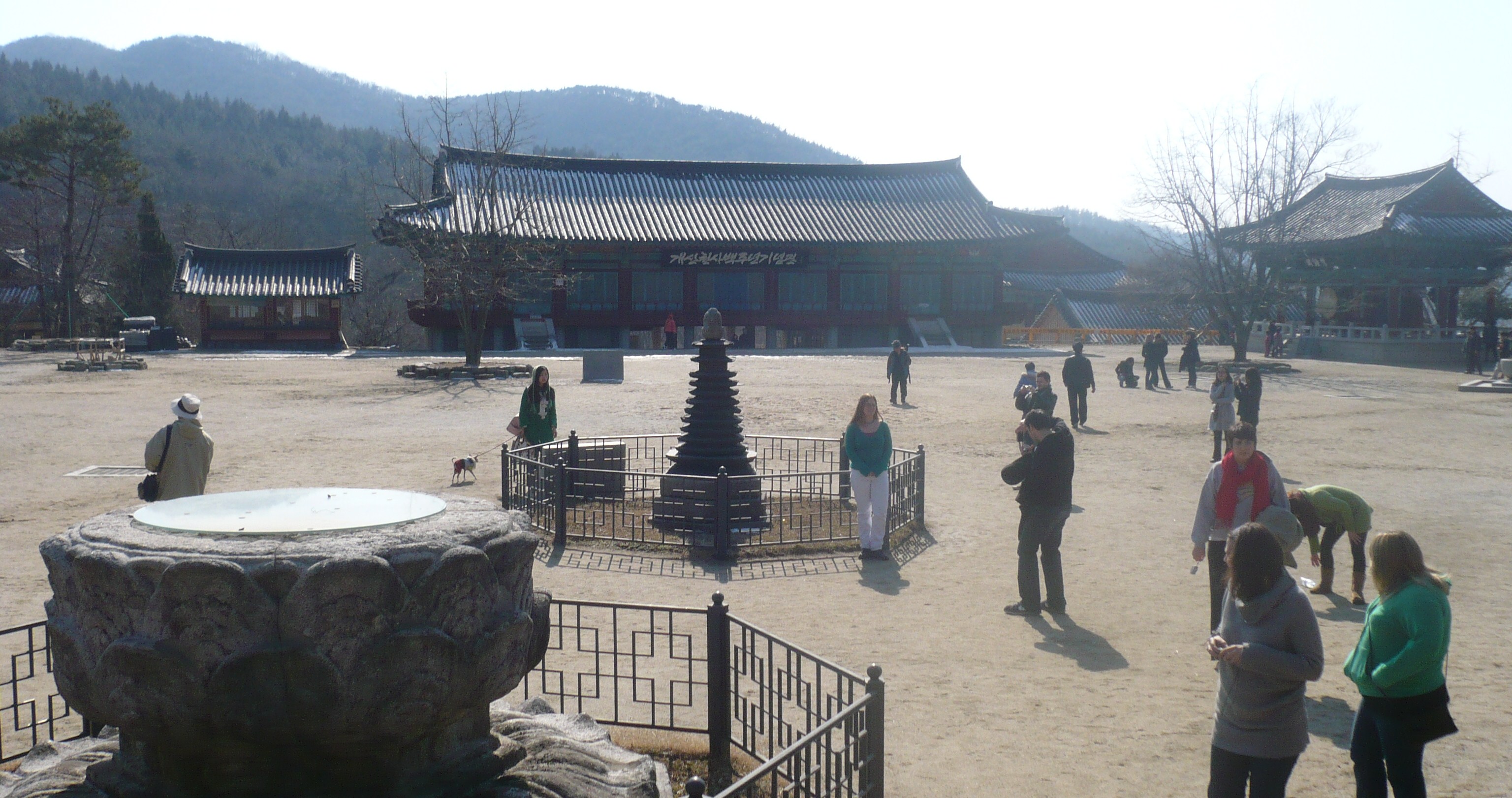
The ancient stupa that is the core of the temple site (i.e. the oldest part, dating in one form or another to at least the 500’s AD):

A cool statue I saw (well-armed, indeed):

The men’s dorm where I slept Saturday night (bathrooms are around back – this is a modern building built to look traditional, but women’s dorm out of sight to the right is quite old and traditional, with a fire-burning ondol heating system) :
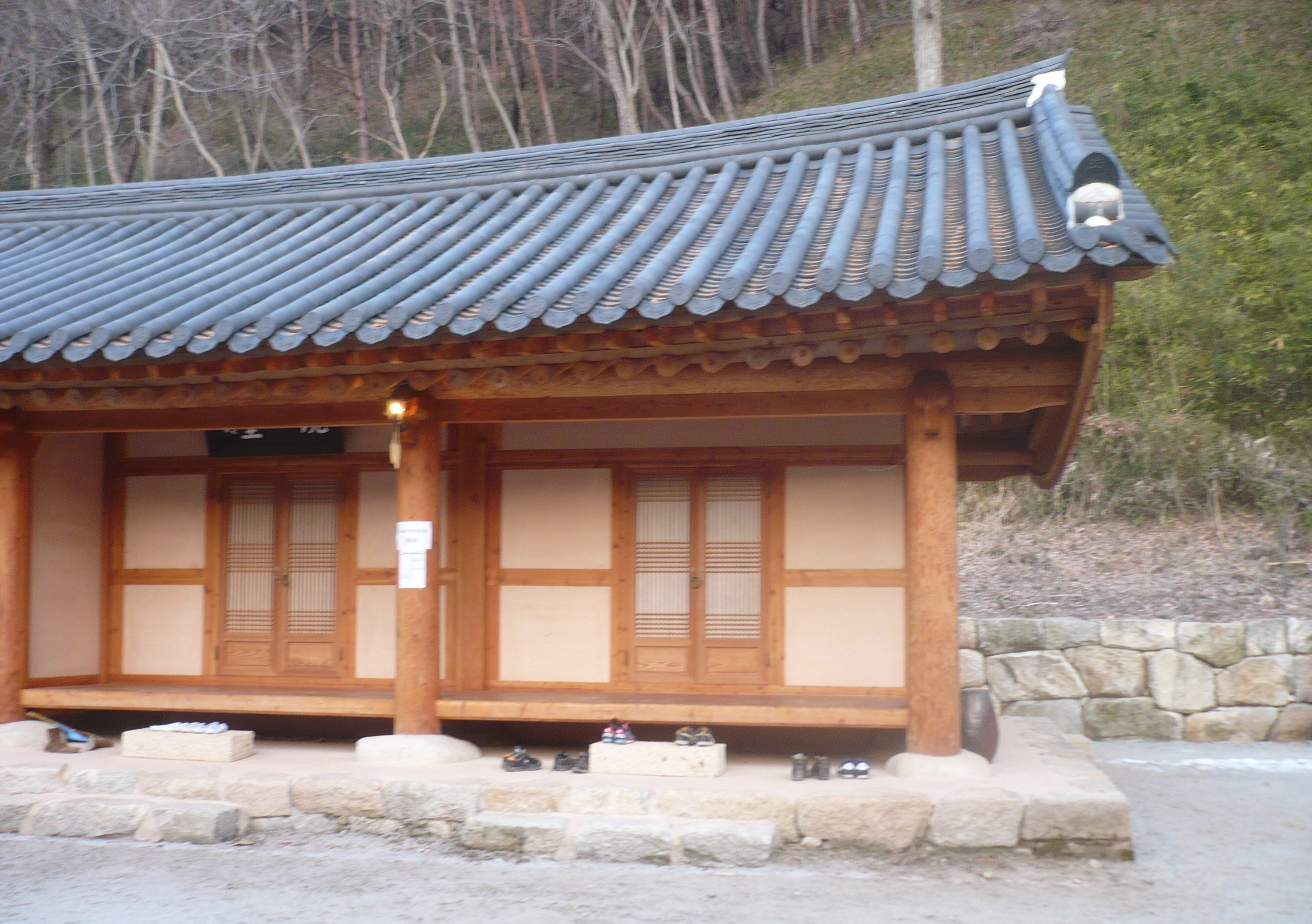
Walking from the dorm area across the stream to the side gate into the main temple courtyard:
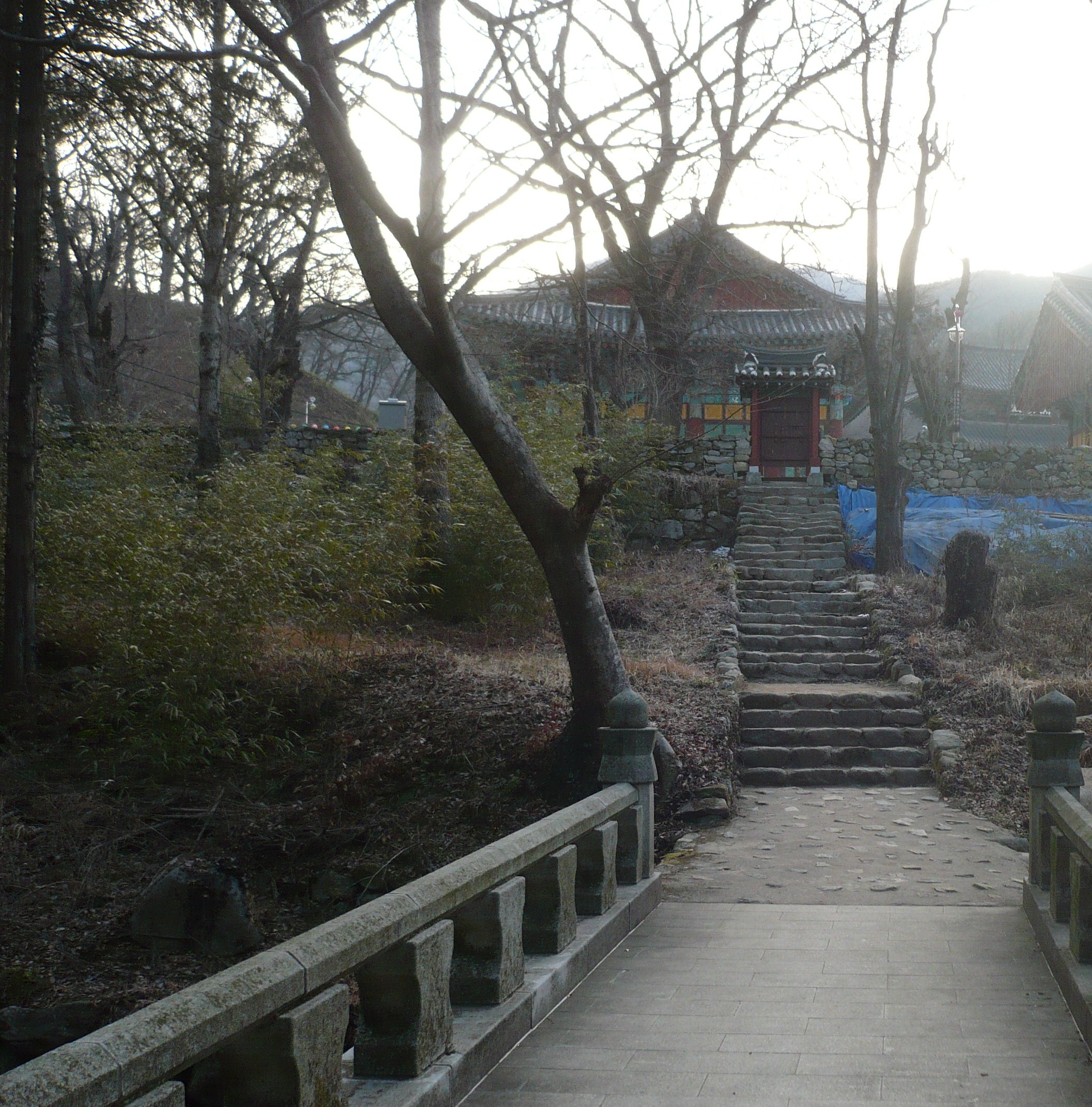
A waterfall that I found while wandering around a ways up the stream beyond the dorm area:
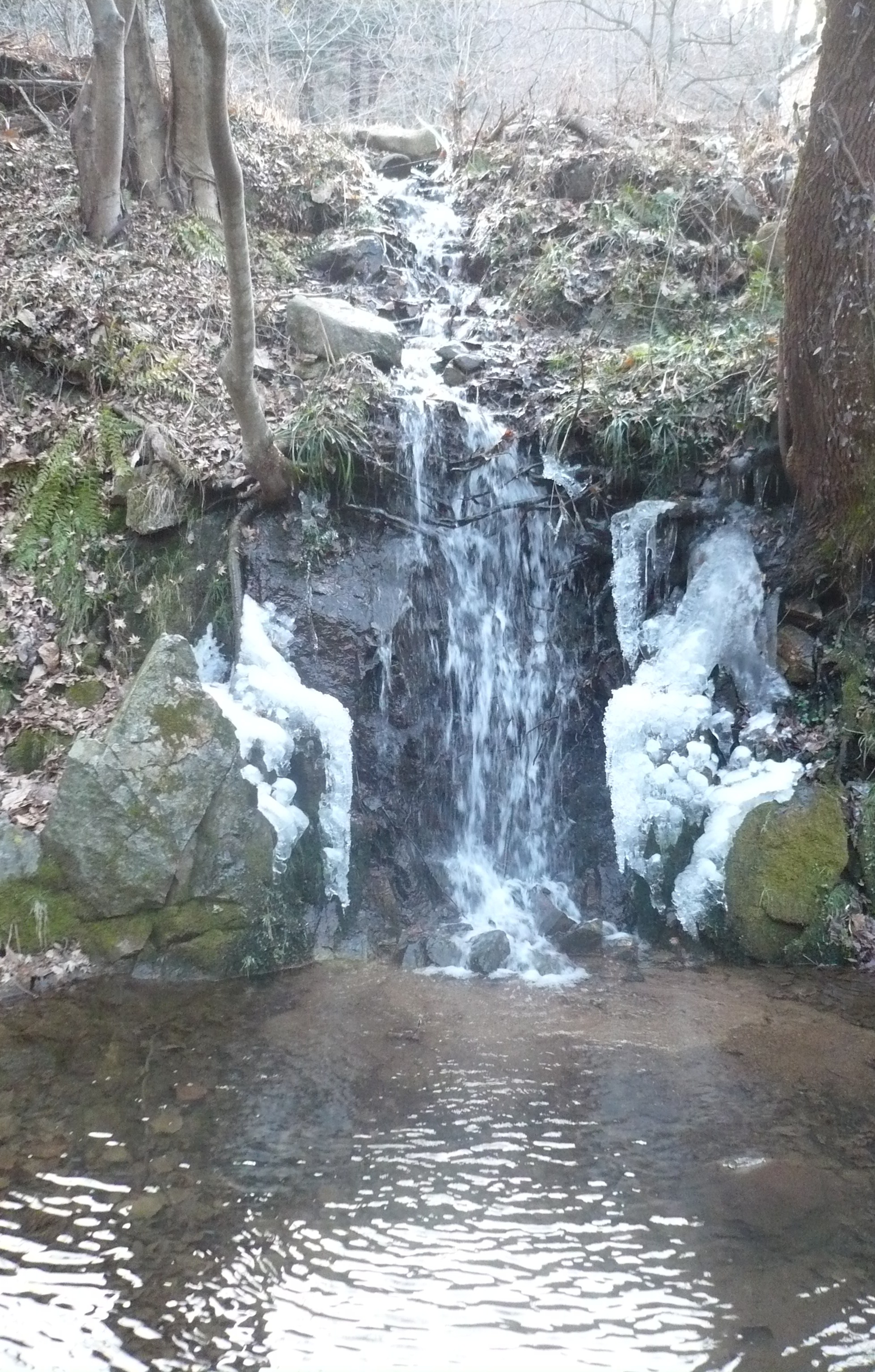
These beads below represent my 108 bows (or prostrations) to the Chijang Boddhisattva. I really did this – it was quite tiring, and yet an old woman came into the temple, about the time I was working on bow number 50 or so, and she did 108 of her own, and finished and had left when I had gotten to my own number 70! I will keep these beads as a souvenir, because each one represents a bow that I actually did:
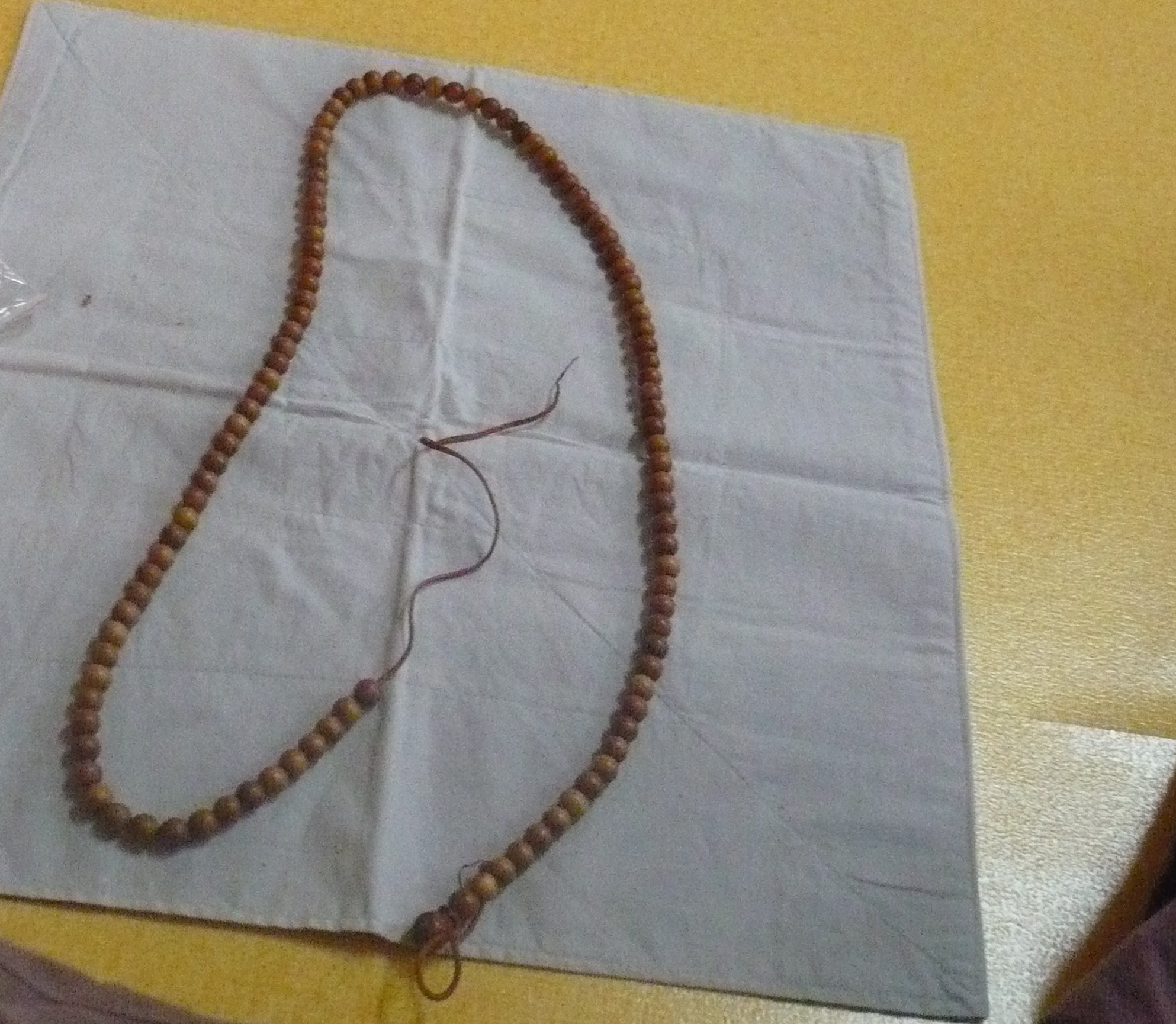
This is the charismatic monk who led the templestay guests around and led us in meditation, etc. He was very friendly, positive, and interesting (despite having an incoherent interpreter):
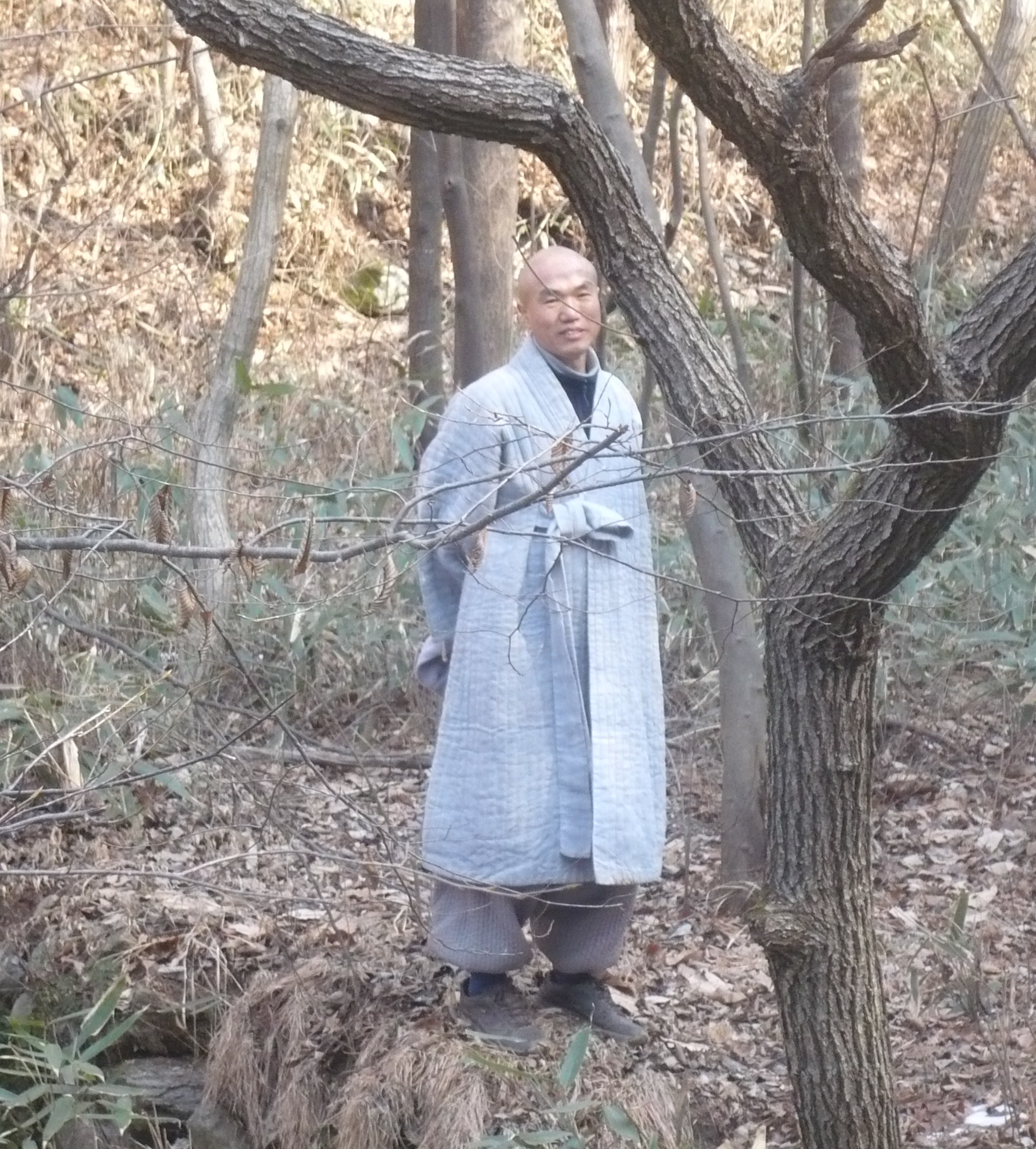
![]()
Caveat: Baru Gongyang
Korean Buddhism has a tradition called 바루공양 (sp? = baru gongyang), which is the idea of eating in a very structured, formalized manner and making sure that absolutely no food is wasted. It's a bit similar in concept to a Japanese tea ceremony, I suppose.
So for breakfast this morning we had a baru gongyang meal. There were four bowls. Food between the bowls should not be mixed during eating, and the sound of chopsticks and spoons against the bowls should be minimized. Also, bowls should be held while eating so that the mouth is hidden from others around you as much as possible.
Before eating, there is a chant:
Where has this food come from?
My virtues are so little that I am hardly worthy to receive it.
I will take this as medicine, to get rid of greed in my mind and to maintain my physical being so as to be able to achieve enlightenment.
The following etiquette rules are given:
Sit cross-legged
No speaking except for chants or recitations
Be careful not to make noise while eating
Always hold bowl while eating
Do not mix food from separate bowls
Do not let your eyes wander while eating
Be mindful of equlity, purity and tranquility
After the chant, we bow, and begin eating. There are four bowls:
Rice (Buddha) bowl
Soup
Water
Side dish (kimchi, radish, some greens)
After finishing, place chopsticks in bowl 2, receive warm water in bowl 1. Clean bowls with the water and a piece of radish that you've reserved, and drink this water – this ensures that no food goes to waste. A second washing is performed and the water is placed into pots. The monk told us that there are hungry ghosts who will drink this cleaning water, but that if there are particles of food in the water, the ghosts will choke and disturb the peace of the monastery.
Finally, you wipe the bowls dry and wrap them up again. You bow and put the bowls away.
I did all this, this morning. It was very interesting. [This is a "back-post" written 2010-02-24]
Caveat: Deistic Distraction
I formulated this last fall, and wrote in a paper notebook. I googled it, and it's unsaid, at least in this form. So I declare authorship of this aphorism at least for now.
"The reason we should not believe in god isn't because there is no god, but because believing in god distracts us from what's important in life."
Here is another quip written nearby in the same paper notebook, that appears original to my own formulation to the best of my ability to research it.
"It hardly matters at all where I end up. Just being there is what's interesting."
Caveat: Watching My Karma Unwind Around Me
I don't actually believe in Karma. Not as Buddhist dogma would have it, with reincarnation and sankharas (sp?) and all that. I believe we each carry a sort of karma within the frame of our own lifespan, as we make decisions, and those have consequences, and things we do to or for others are repaid in part or in full or passed along. Creative expression is a means of extending the reach of one's own personal karma, in this respect.
I seem to have a tendency, in my life, to seek out and find myself in situations where I've deliberately created too many options for myself. So many options, that it's very hard to make a move — I sit in a sort flux of indecision, like standing hip-deep in a stream and feeling the current tug at you.
So there I am. I'm working on the job search. But that's a slow, evolving process that requires a good deal of patience. I'm working on studying Korean, but that's an even slower, evolving process that requires more patience than the Buddha himself has. The Buddha may have lost his equanimity, had he decided to try to learn Korean. Heh.
I have a lot of "free" time, and I'm not spending it well.
Caveat: I broke a neuron
I’m back from my 11 day “meditation retreat.” So strange… Really, it was basically ten days as an initiate buddist monk in the burmese theravada tradition. Very strict, very intense. Very quiet — no talking except once-daily interviews between instructors and students. No access to computers, cellphones, music, books, paper, pencils or pens. Etc.
My friend Bob, before I left, said to me: “I don’t know what to say to someone leaving on a meditation retreat. Maybe: ‘Break a neuron!'” (analogous to “break a leg!”).
Caveat: Rescuing the cat
Upon leaving the meditation center, my fellow meditator Richard decided to rescue the stray cat (see posts from day 6 and day 9). I offered to drive him into Chicago, where he lived, since he didn’t have transportation planned that could include the transport of a stray cat.
We took the cat in my truck, and we talked a lot as we drove down I-90 into the city. Richard lives in Hyde Park, which is the neighborhood in Chicago where I lived 24 years ago (24!). I only lived in Chicago for a short time, but it has always been one of my favorite cities and places.
We got take out from Harold’s Chicken Shack, which is a chain of Chicago south-side fast-food joints that I remember very fondly from when I lived there. The branch we went to didn’t exist when I lived there, but it was located in the same exact shopping center at 53rd and Kimbark where I used to work. Here is a picture of Kimbark plaza, and the CVS pharmacy at the far end used to be a hardware store, where I worked.
Here is a picture of the Harold chicken. Note the delicious slices of squishy white bread that are served to soak up the juices of the fried chicken.
Then we went to Richard’s apartment, smuggled the cat in, and had some lunch. The cat seemed very content. Richard lives on the 24th floor of a high rise near Lake Michigan. The view from his apartment is amazing.
I drove past 62nd and Kimbark, where I used to live, but the neighborhood is unrecognizable from 24 years ago — I think the Univ of Chicago has redeveloped the area substantially.
Finally, I drove back up toward Wisconsin. As I passed through downtown, it was beginning to snow. Chicago is such a stunningly beautiful city, to me. I found an old Psychadelic Furs song on the radio. I crawled through Sunday traffic on the Kennedy Expressway. I felt very joyful.
![]()
Caveat: Bhavatu Sabbu Mangalam
Here is a list of the entries I have written (or will write over the coming days) about my experience at the Vipassana meditation retreat.
Here is a picture of the retreat center, taken this morning after I got my camera out of storage.
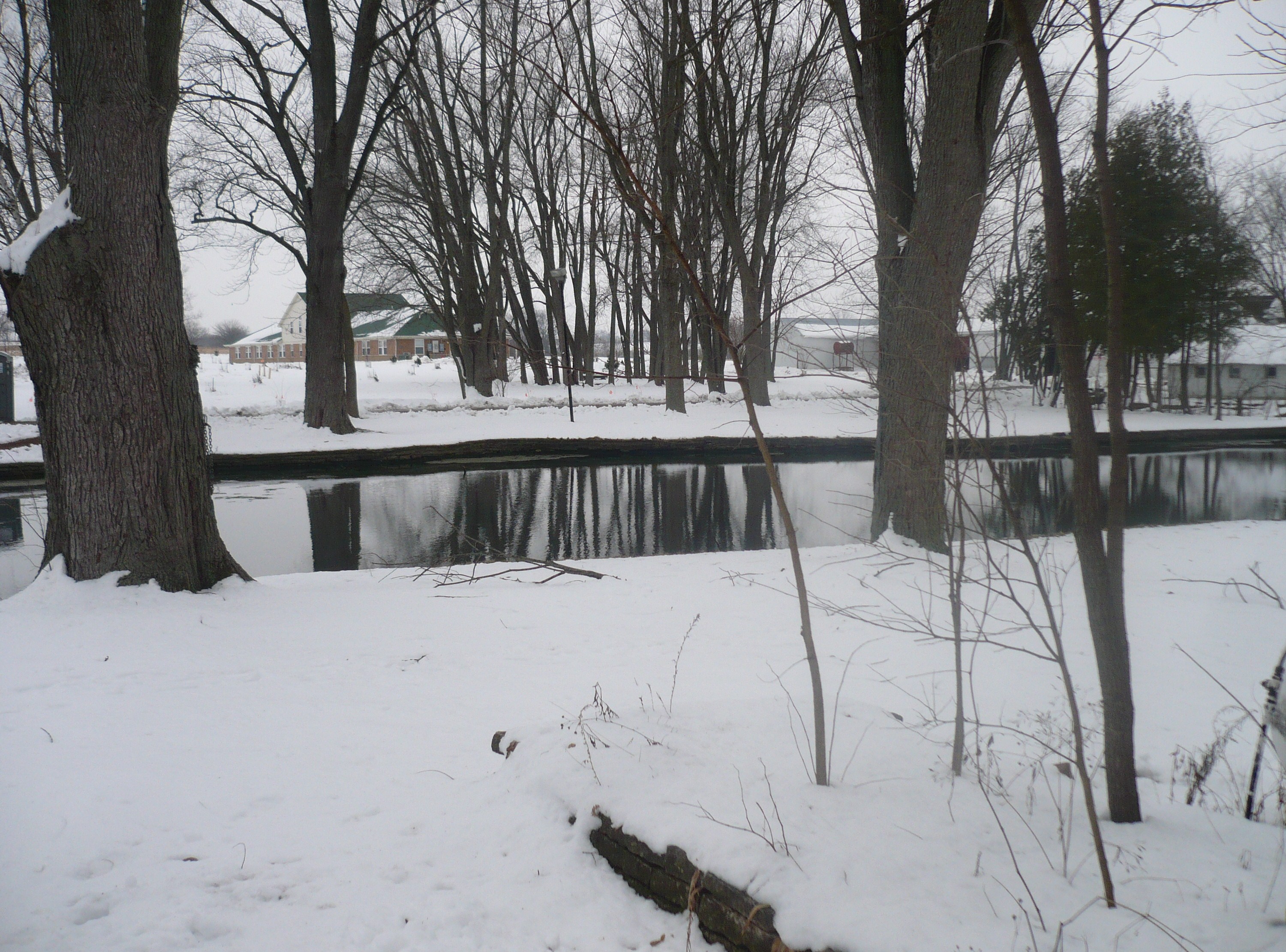
![]()
Caveat: 개구리도 움츠려야 뚼다
[This is a “back-post”; it is a work-in-progress, so it may change partially or completely, with materials added or taken away, over the next several days or weeks. This is “day 10(c)” of my stay at the Vipassana Meditation retreat. For general comments and summary, see “day 11.”]
The phrase in the title to this post is a Korean proverb: “even a frog must crouch before it can jump.”
I never really could remember what else I meant to write here. That’s a disadvantage to “blogging in one’s head.”
Caveat: Gnarled, twisted, naked tree. Snow.
[This is a “back-post”; it is a work-in-progress, so it may change partially or completely, with materials added or taken away, over the next several days or weeks. This is “day 10(b)” of my stay at the Vipassana Meditation retreat. For general comments and summary, see “day 11.”]
The strict rule of silence ended, and I felt a feeling of relief, sadness, and frustration. Relief, because I was feeling fed up with the program. “Done.” Sadness, because I was, nevertheless, getting a lot out of it, and enjoying the focused, disciplined detail of the moment-to-moment. Frustration, because I had hoped I would have liked the program more… that I might have gotten more out of it.
Overall, however, I felt a sort of joyful equanimity. Not, perhaps, the sort of equanimity that Goenka would approve of: I was joyful to be IN the world, living it it, experience its beauty and complexity. No non-attachment, for me. I guess maybe I still don’t “get it” ?
There was this bench that I would like to spend time visiting briefly, during the short breaks between meditation sessions. It was right outside the “men’s entrance” of the meditation hall. I would go out and lie down on it, looking up at the sky through the branches of the tree. Night sky, with clouds and distant Chicagoglow, or with stars, or day sky, cloudy, or blue. But always quite cold. The warmest things got during the retreat was maybe low 30’s F.
I lay down on the bench and looked up at the tree. Snowflakes landing on my face.
Here is a picture of the bench [taken after I got my stuff back on day 11].
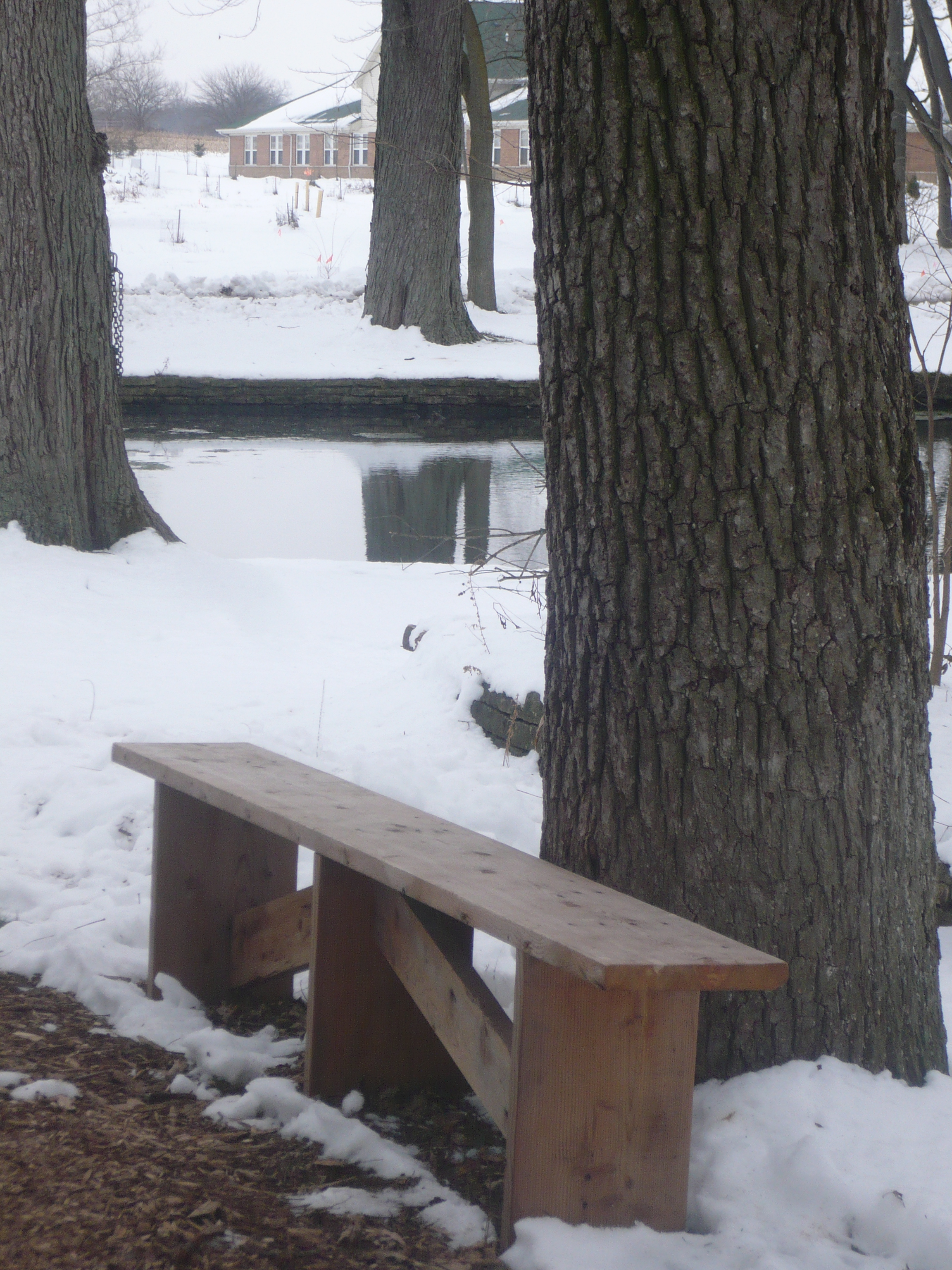
Here is a picture looking up at the tree [taken after I got my stuff back on day 11].
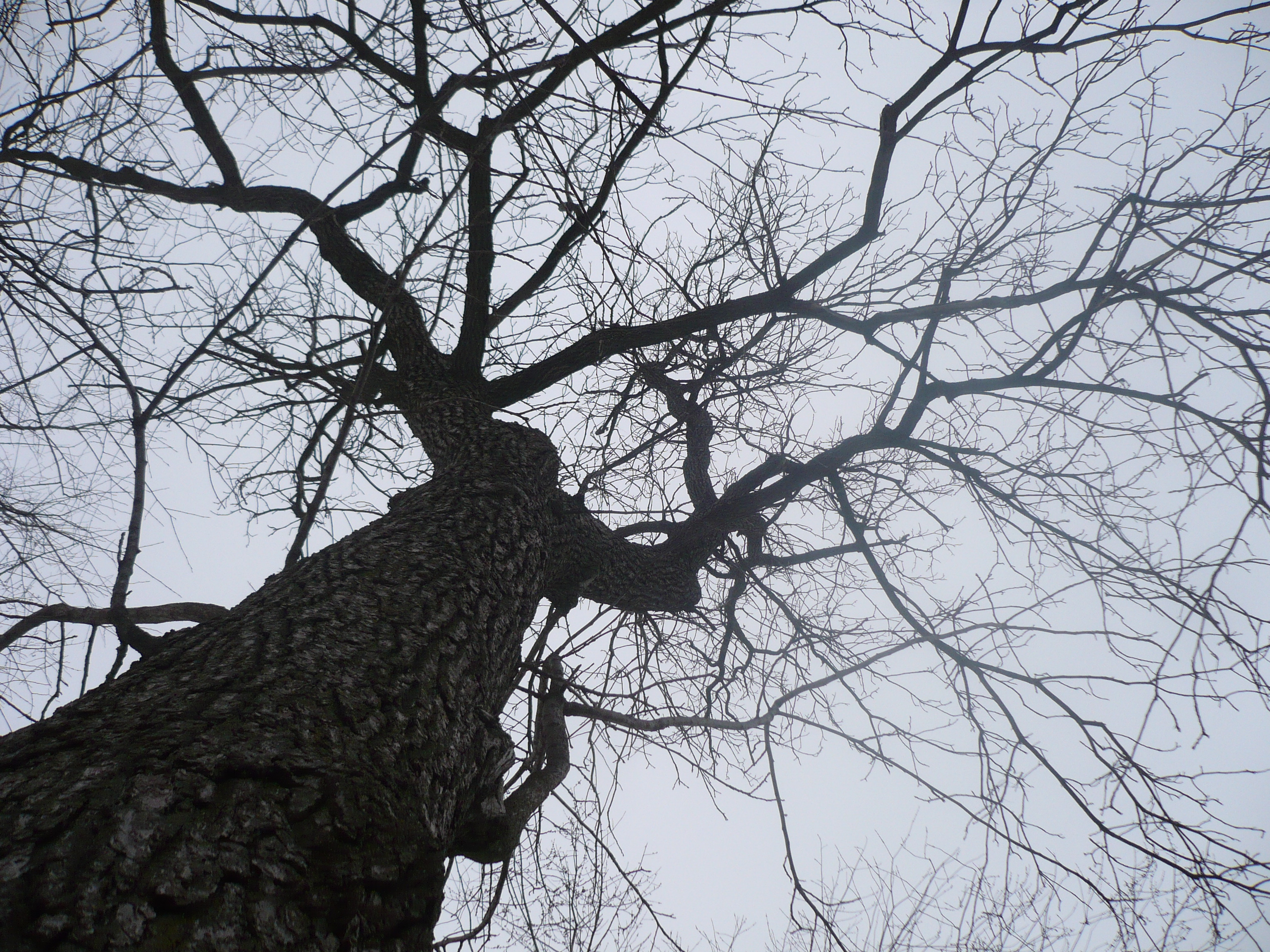
![]()
Caveat: No vibrations. No Christ. No love.
[This is a “back-post”; it is a work-in-progress, so it may change partially or completely, with materials added or taken away, over the next several days or weeks. This is “day 10(a)” of my stay at the Vipassana Meditation retreat. For general comments and summary, see “day 11.”]
My problem with purity.
Purity is a problematic concept. It seems well and good. And it has all sorts of cultural manifestations, and seems close to a human universal.
But purity, and concommitant, oppositional notions like “pollution” and “defilement,” are dangerous memes. When applied to cultural and psychological constructs, they seem to lead down a slippery slope to intolerance and fanaticism, almost unfailingly.
Caveat: 1-800-SUICIDE
[This is a “back-post”; it is a work-in-progress, so it may change partially or completely, with materials added or taken away, over the next several days or weeks. This is “day 9(d)” of my stay at the Vipassana Meditation retreat. For general comments and summary, see “day 11.”]
This is a very grim title. But actually, it’s not a negative moment. There’s a raucous rock song by a group called Zeromancer, entitled “Doctor Online“. It has the line “1-800-suicide” as part of its chorus.
It is stuck in my head, this evening, after a minor epiphany. I’d returned to my room, after tea… after my weeping during meditation earlier. After my loss of equanimity.
And I somehow decided, or realized, that setting aside “desires and aversions” – losing my attachment to these things… this seems like a kind of “spiritual suicide.” I mean… its our desires and aversions that let us know that we’re alive, right? If we no longer have desires and aversions, mightn’t we as well be dead?
I think the more nuanced view is that it’s not that we’re to get rid of desires and aversions, but only that we’re to lose our attachment to the results of our actions that those desires and aversions engender. But Goenka, in his presentations and discourses, utterly fails to convey this nuance clearly. And the more blunt view (which seems to prevail in a lot of Theravada) that nirvanna (enlightenment) is all about letting go of desires and aversions altogether seems too shallow to me. Too much like quitting the world in the name of happiness. Too much like giving up.
So the song was stuck in my head. But it restored my equanimity. Although it left me with a certain degree of apathy vis-a-vis the meditation program.
Caveat: An ant on the wall. Pushing back.
[This is a “back-post”; it is a work-in-progress, so it may change partially or completely, with materials added or taken away, over the next several days or weeks. This is “day 9(c)” of my stay at the Vipassana Meditation retreat. For general comments and summary, see “day 11.”]
I am in the bathroom, and I notice an ant. The ant appears to be damaged. Wounded. The back legs don’t seem to be working very well. I worry that maybe I stepped on it accidentally, or hurt it some other way.
The ant is trying to climb up the wall. It will make it up one foot, maybe two feet. And then it will fall down to the floor. It will walk a little way along the base of the wall, and the climb the wall again. And fall down. It did this 5 or 6 times.
Trying.
Trying.
Trying.
And then it walked along the base of the bathtub, around behind the toilet, where it stumbled into a spider web. It struggled, there, for a short time. And then stopped.
Shortly before, I’d returned to my room after 5 o’clock tea. I was restless, and frustrated, and sad. I was looking forward to doing push-ups in my room. This was, perhaps, the first time ever that I’d looked forward to doing push-ups.
Stir-crazy: I did 150 jumping jacks, and 30 push-ups.
As I did my illicit exercise (it seems it’s not technically considered desirable to have aerobic exercise during the intensive meditation course), I thought about “the world pushing back.”
What does this mean, the world pushing back? We can’t stop wanting things. We can’t stop feeling aversion to things. Desire and aversion are things that let us know that we’re alive. That’s the world, pushing back. Just like being down, doing push-ups: the world pushes back, hard. That’s gravity.
I’m not sure what I’m getting at. I guess I just feel that to speak of eliminating desires and aversions is ridiculous. It’s like choosing to be dead. You can only let go of your attachment to the outcomes (results) of actions brought on by desires and aversions. But that’s important. I think about David White’s discussions of the philosophy of non-attachment as outlined in the Bhagavad Gita.
Caveat: Snort-love
[This is a “back-post”; it is a work-in-progress, so it may change partially or completely, with materials added or taken away, over the next several days or weeks. This is “day 9(b)” of my stay at the Vipassana Meditation retreat. For general comments and summary, see “day 11.”]
..
I took some pictures after the course ended and I got my camera out of storage. This is the previously-mentioned cat, named Snort, coming out of her barn where she was hiding from the cold wind
This is a close up
Caveat: Sanctimonious metaphysical nonsense
[This is a “back-post”; it is a work-in-progress, so it may change partially or completely, with materials added or taken away, over the next several days or weeks. This is “day 9(a)” of my stay at the Vipassana Meditation retreat. For general comments and summary, see “day 11.”]
Do I need to say more?
Caveat: A constellation of capsaicin
[This is a “back-post”; it is a work-in-progress, so it may change partially or completely, with materials added or taken away, over the next several days or weeks. This is “day 8(d)” of my stay at the Vipassana Meditation retreat. For general comments and summary, see “day 11.”]
I am feeling pretty gloomy.
I have been putting a pinch of cayenne pepper in my tea in the afternoons. I like spicy things, and red pepper in tea (in tiny amounts) can be good.
I sat and looked at the dregs of my tea, and the little red flakes of cayenne floating there. It looks like constellation of stars. The world is interesting.
Caveat: The Parable of the Secret Gift
[This is a “back-post”; it is a work-in-progress, so it may change partially or completely, with materials added or taken away, over the next several days or weeks. This is “day 8(c)” of my stay at the Vipassana Meditation retreat. For general comments and summary, see “day 11.”]
One thing I spend my time doing, as I sit and let my monkey mind wander, is that I invent parables and stories and jokes. I made up this parable.
There was a class of children and their teacher. The teacher was strict but well-meaning. One day, he told the students he was going to give each of them a gift. But he warned them: “This will be a personal gift, just from me to each of you individually. Do not share your gift with your peers or talk about it with each other. It’s to be between each of you and me, alone.”
The next day, he brought a small, elegant box for each of his students. He passed them out carefully to them, make sure that each received the correct box. Then he told them that they could look in their individual boxes. “But you must look carefully and privately. Do not share the contents of your boxes with your peers. As I said, this is a personal gift, tailored and unique to each of you individually.”
The students all opened the lids of their boxes and peered, discreetly, inside. There was one student, who always worked hard in class but didn’t always necessarily get great results. He looked into his box and realized it was empty. He looked around at his peers, and saw all of them smiling happily, seemingly satisfied with their secret gifts. He tried to put on a smile, and imagined that some of them, too, might have empty boxes, and that they too were pretending to be happy for the sake of appearances.
The teacher began to talk again, and he described the types of the gifts he had given, in general terms. They sounded very wonderful. The student felt more and more frustrated and sad, but he kept his equanimity. Equanimity was an important trait, according to their teacher.
Then the teacher said, “some of you may not have received a gift. If you don’t have a gift, you must not feel disappointed. You should not become depressed or feel dejected. Someday, you may still get a wonderful gift, but for now, what you have right now is what you have. Keep your equanimity.”
The student suddenly felt overwhelmed by the exact feelings his teacher was telling he should not have. He suddenly lost all self-control and equanimity, and burst into weeping. It simply wasn’t fair. And somehow, having his teacher insist that such unfairness must be borne in equanimity was a kind of last straw, and he completely lost it. He wept and wept.
Caveat: Fantasies of the real
[This is a “back-post”; it is a work-in-progress, so it may change partially or completely, with materials added or taken away, over the next several days or weeks. This is “day 8(b)” of my stay at the Vipassana Meditation retreat. For general comments and summary, see “day 11.”]
Or the real as just fantasy. Solipsism and all that.
I never really could remember what else I meant to write here. That’s a disadvantage to “blogging in one’s head.”
Caveat: Salvation through proprioception
[This is a “back-post”; it is a work-in-progress, so it may change partially or completely, with materials added or taken away, over the next several days or weeks. This is “day 8(a)” of my stay at the Vipassana Meditation retreat. For general comments and summary, see “day 11.”]
Proprioception – our awareness of our own body, its position and extent and activity. It seems the main idea of vipassana is that through a very intensive proprioception, combined with a strong “equanimity” to the sensations involved, we can allow old karmic “sankharas” to “float to the surface” and “evaporate.” I find the metaphor lovely, but the whole thing is physiologically implausible.
Caveat: The Body Without Organs (you wish!)
[This is a “back-post”; it is a work-in-progress, so it may change partially or completely, with materials added or taken away, over the next several days or weeks. This is “day 7(b)” of my stay at the Vipassana Meditation retreat. For general comments and summary, see “day 11.”]
The title is a reference to philosophers Gilles Deleuze and Felix Guattari’s concept, as developed in the Mille Plateaux.
I never really could remember what else I meant to write here. That’s a disadvantage to “blogging in one’s head.”
Caveat: A muskrat chases a goose
[This is a “back-post”; it is a work-in-progress, so it may change partially or completely, with materials added or taken away, over the next several days or weeks. This is “day 7(a)” of my stay at the Vipassana Meditation retreat. For general comments and summary, see “day 11.”]
I really saw this. There is a pond fed by an artesian spring at the retreat center. There appear to be two muskrats living in it. During the day, sometimes migrating geese stop and feed and rest -the water is unfrozen because of the flow into it from the spring, so it must make a pretty good oasis during the cold days of winter. I can’t figure out if the muskrats are guided by territoriality, hunger, or a sense of play, but one of them or the other will literally sneak up on a floating goose and begin to chase it through the water, until the goose becomes so rattled that it takes off and flies to the bank of the pond for a short time. I saw both muskrats doing this, over and over, and it made me laugh out loud. A violation of the code of silence. …
The world is funny and interesting, even if these neo-orthodox buddhists take themselves too seriously. Misery? What misery?
Caveat: I <3 My Monkey Mind
[This is a “back-post”; it is a work-in-progress, so it may change partially or completely, with materials added or taken away, over the next several days or weeks. This is “day 6(b)” of my stay at the Vipassana Meditation retreat. For general comments and summary, see “day 11.”]
The buddhist term for the mind that wanders and makes problems for someone dedicated to trying to meditate is the “monkey mind.” I have a monkey mind, but what I’ve decided, this morning, is that I LIKE my monkey mind. It’s very interesting to watch, as I sit here trying to focus on the sensations in my body.
As my mind has cleared itself of the more immediate worries (will my truck start after 11 days in cold? will I get a job in Korea when I go back? will I ever learn Korean well?), I begin to daydream. I have been observing what sorts of things I tend to daydream about, and as I watch closely, I find some things that surprise me a little bit. Here is a catalog of my most common daydreams, in the order in which they most commonly occur:
Most common are my architectural fantasies. This is something I’ve always been aware of — I have wanted to become an architect since I was about 7 years old, but it never worked out. I constantly daydream about buildings. Rearranging existing ones, replacing existing ones with “better” ones, completely new ones. All kinds: commercial structures, houses, apartments and towers and office parks and cathedrals and new vipassana meditation halls. Elaborate, baroque-looking structures and designs, spare and utilitarian designs, revolutionary and avant garde designs and classical designs.
Related to this, I often have what I refer to as “homestead” fantasies. These are where I imagine creating some kind of home for myself. A farm, a remote mountain location, a warehouse loft in a city, etc. I imagine barns and libraries and workshops, tiny single-room cabins and giant palaces. But a key factor is that they’re things I build at least to some extent “by myself.” I suppose this is actually quite understandable, given my background. My mother and her brother, my uncle, both live in self-designed homes, in Australia and Alaska respectively. The house I grew up in, in Arcata, was an evolving space that didn’t retain the same floor plan in the 17 years I spent there, as rooms were added, rearranged, “re-architected” (as a software guy might term it).
Unrelated, and more surprising, is the amount of time I spend daydreaming about food. What’s interesting, is that I’m not thinking about EATING it, but rather, making it. Cooking exotic or unusual or interesting dishes. Fantasizing about becoming a chef or running some hole-in-the-wall restaurant. This is so prevalent that I wonder if maybe I should consider a career in cooking. Maybe next career? Who knows. At the least, I should listen to this inner daydreamer and dedicate more energies to being creative in the kitchen, perhaps.
Not unexpectedly, I’m constantly working through settings, descriptive passages, characterizations and plots of novels-in-progress. I don’t really get much actual writing done on these novels, but I certainly spend a lot of time writing them. I also do some mental “writing” on my perennial thesis (on Cervantes’ Persiles), and on some putative autobiography or memoir of my experiences and travels.
I like to work through visual arts in my mind’s eye, too. This is related to the architecture daydreams, and the two will often blur into one another. I imagine decorated surfaces, sculptures, and classically executed drawings and oil paintings (although the style is most often abstract or occasionally surrealist).
Most surprising and unexpected are the romantic fantasies. I mean… it’s not unexpected that I have romantic fantasies. These are nearly universal, to anyone, I think. Certainly, I’ve always had them. What’s different from in previous times in my life is the weird way that these daydreams are “domestic”: never before have I had frequent fantasies of the “settle down and have kids” variety. I find myself imagining having children. This is disorienting and alarming, because it’s so out of character, at least to compare to past selves. It’s also a bit depressing… because it’s only now, when I’m really “too old” to start a family, that I suddenly find myself yearning for one. Perhaps I’m enjoying teaching so much, because it serves as a kind of surrogate for these have-a-family fantasies?
So, my monkey mind is conjuring both familiar and unexpected daydreams. But what I’ve decided, over these last several days, is that regardless, it’s very interesting to watch. I really actually enjoy it. I don’t WANT to turn it off. I don’t feel any need to turn it off. Let it roam and hop and jump around, and I’ll watch it happily for hours on end. It’s not like anxiety or depression at all. It’s fascinating.
Monkeys rock! I {heart} my monkey mind.
![]()
Caveat: …………………….ddddddddddddddssdfrwwafff.cat
[This is a “back-post”; it is a work-in-progress, so it may change partially or completely, with materials added or taken away, over the next several days or weeks. This is “day 6(a)” of my stay at the Vipassana Meditation retreat. For general comments and summary, see “day 11.”]
My internal monologue, which is so hard to shut up, patters on and on, as I try to focus on awareness of my breathing, on the respiration on my upper lip, on the sensations on my body. I often think “textually.” Because I type so much, so often. So sometimes (and not just during this meditation adventure, but always, in general) my monologue takes the form of text-on-screen or text-on-paper. I see the writing, as opposed to hearing my own voice, I guess.
As I tried to quiet my internal monologue, I had this weird visual of trying to shut up the text-on-mind’s-screen, and began to visualize dot-dot-dot: . . . . . . . . . . . . . .
And then, much to my amusement, the monkey in my brain (one of an infinite number of monkeys, perhaps) began to hit other keys: a long series of D’s, and then random characters. Very strange, very amusing. I almost began laughing out loud. And certainly, I wasn’t doing very well with the meditation task.
Later.
There is a cute cat that appears stranded or stray. It’s living in a barn just off the pathway between the mediation hall and the dormitory building. It’s been so cold these days… I worry about this cat. He (she?) comes out and purrs loudly, looking for attention. If you crouch down, it will try to climb into your lap. Seeking warmth or shelter. According to the code of silence, we’re not supposed to talk or interact with people, except the instructors… but I’m not sure about cats. I’m choosing to interact with the cat, when I see it. Petting it, and muttering hellos.
Caveat: The fetishization of misery
[This is a “back-post”; it is a work-in-progress, so it may change partially or completely, with materials added or taken away, over the next several days or weeks. This is “day 5(b)” of my stay at the Vipassana Meditation retreat. For general comments and summary, see “day 11.”]
I remember back on day 2 (or was it day 1?), I had this weird thought, during Mr Goenka’s discourse: “Wait! What misery?”
He was going on and on about misery. We are all suffering. We’re suffering, even if we don’t know we’re suffering. And then, of course… vipassana is the presumed “cure.”
But, my thought is… is there really that much misery? Isn’t there a lot of beauty, too? A lot of love?And kindness? Some people are miserable, true. Sometimes. I was pretty consistently miserable, for many, many years. For most of my life, even. But I seem to be getting over that. Emerging from it. And the way to get over it doesn’t seem to lie in obsessing over how miserable I am. At least, that doesn’t work, for me.
So even if he’s proposing a “cure,” it seems very counter-productive, downright negative, to spend so much time going on and on about how miserable we all are. There’s no happiness, there. Perhaps, with enough meditation, there may come about a kind of equanimity… but who wants equanimity to universal suffering? How about, instead, some just plain happiness? A better deal, surely…
![]()
Caveat: The pain in my ass
[This is a “back-post”; it is a work-in-progress, so it may change partially or completely, with materials added or taken away, over the next several days or weeks. This is “day 5(a)” of my stay at the Vipassana Meditation retreat. For general comments and summary, see “day 11.”]
One shouldn’t underestimate the sheer difficulty of simply sitting. I think to be a successful meditator, you need to think seriously and intelligently about what I have decided to term the Technology of Sitting. What position? What cushions? What other apparatus and support? Etc.
Because, let’s get right down to it: I spend a huge proportion of my time meditating thinking about nothing except the pain in my ass. Or legs. Or back. Or foot. Or wherever. About how I should have moved such and such cushion to such and such location, how that would be so much more comfortable. Maybe.
This school of meditation doesn’t place a lot of emphasis on position or posture. They do require stillness, however. Strong determination. And stillness requires a modicum of, if not comfort, at least a kind of ease with one’s position and posture.
Therefore… I think a successful introduction to vipassana meditation might best include more overt and open discussion of posture and sitting. A la yoga, or tai chi, or something, maybe. Some kind of analysis and training on the Technology of Sitting.
Caveat: Adhitthana
[This is a “back-post”; it is a work-in-progress, so it may change partially or completely, with materials added or taken away, over the next several days or weeks. This is “day 4(b)” of my stay at the Vipassana Meditation retreat. For general comments and summary, see “day 11.”]
“Adhitthana” means “strong determination.”
Today, we have been told that we should be “sitting with strong determination,” which means sitting still: not changing position, not changing posture, not opening up hands.
Why is this? I understand it. It’s discipline. But it’s very difficult. The first time I try it, I struggle so much with the pain and ache in my legs and back, that I’m not really doing any kind of meditation of any kind. Just sitting, with strong determination.
The second time goes better. I spend some time on anapana – observing the respiration on my upper lip. Observing.
Observing.
Pain in my legs, but not unbearable. Cross-legged, sitting.
There’s a kind of exhilaration when the hour finishes. I feel accomplishment. Not sure that’s the objective. But by the end of the hour of sitting perfectly still, I also feel these weird spots of “non-sensation” in parts of my body: mostly in the hands and arms. It’s not numbness, but there’s nothing to feel, so it’s like a hole in the self-body-map. All it takes is slight flexing of the muscles in the hand, and it feels perfectly normal. So strange.
Caveat: Foucault’s Fun Farm
[This is a “back-post”; it is a work-in-progress, so it may change partially or completely, with materials added or taken away, over the next several days or weeks. This is “day 4(a)” of my stay at the Vipassana Meditation retreat. For general comments and summary, see “day 11.”]
It’s all about the discipline.
Michel Foucault is one of the most notable philosophers of the 20th century, and I would say his most influential work on me personally was his Archeology of Knowledge (which, incidentally, I read the first time in Spanish translation as Arqueologia del saber). Nevertheless, perhaps one of his most widely-known works is Discipline and Punish, and within my imagination, Foucault’s name is synonymous, perhaps unfairly and certainly inaccurately, with certain notions of the weird give-and-take of our relationship, as individuals and more broadly as a civilization, with discipline, both external and internalized.
So I have coined the term “Foucault’s Fun Farm” for this entirely voluntary retreat that is so focused on concepts of discipline. The disciplinary aspects include everything from the hours we keep to the food we eat, to the way we interact (or refuse to interact) with one another, to the way we sit and think (or not think). The fact of the matter is that I like it.
The same way that my favorite part of my military experience was the training — when discipline was maximal (and things seemed profoundly ethical and fair), and meaning was almost non-existent. The same way that I can sometimes be nostalgic for a long stay at a hospital, where everything is structured and predictable.
Because one of the things I most lack in my life, is self-discipline. Or…well… I feel that I lack it. I’m better than I once was, really. But I came here, ultimately, as much for the discipline as for the meditation, per se. Certainly, I didn’t come for the Buddhist dogma. That last is just a sort of adjunct, an annoyance… a gnat.
Beware dogmatic gnats. They’ll bite you.
Caveat: O blessed itching sensation
[This is a “back-post”; it is a work-in-progress, so it may change partially or completely, with materials added or taken away, over the next several days or weeks. This is “day 3(b)” of my stay at the Vipassana Meditation retreat. For general comments and summary, see “day 11.”]
This is pretty self-explanatory. I tried to make peace with the itching sensations. Not very easy to do.
I never really could remember what else I meant to write here. That’s a disadvantage to “blogging in one’s head.”
![]()
Caveat: Touch of Desperation
[This is a “back-post”; it is a work-in-progress, so it may change partially or completely, with materials added or taken away, over the next several days or weeks. This is “day 3(a)” of my stay at the Vipassana Meditation retreat. For general comments and summary, see “day 11.”]
The main teacher of the Vipassana movement, whom we watch speaking in videos each evening, has a strong Hindi accent. When he talks about our practice of “anapana” (meditation on feeling our respiration on and around our noses and upper lips), he uses the phrase “touch of respiration” – but his accent renders this “touch of desperation” to my ears. And that’s a bit how I’m feeling.
![]()

